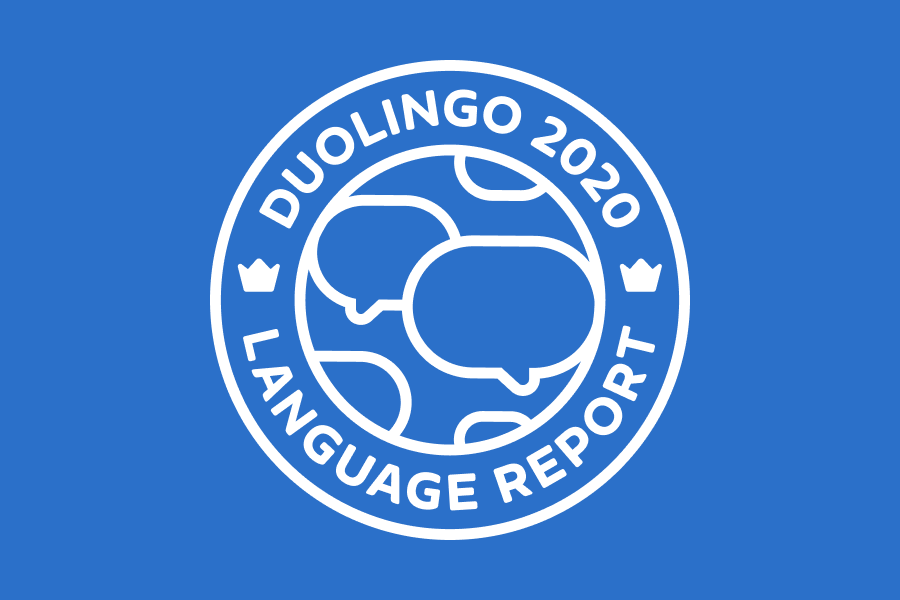Language learning trends in a year like no other
Foreword by Luis von Ahn
We created Duolingo in 2011 with a mission to develop the best education in the world and make it universally available. I’ve always felt that economic inequality is one of the biggest problems facing humanity, and education is the best way to help most people around the world improve their lives. Our vision is to create a world where more money can’t buy you a better education.
In the last nine years Duolingo has become the most popular way to learn a language globally and the most downloaded education app in the world. Our approach has allowed us to achieve enormous scale with over 500 million total users and around 40 million monthly active users, representing every country in the world. We are a very data-driven company: we test and measure everything we do, and we use this data to constantly improve how we teach. As a result, we have more insight into global language learning trends than any other entity in human history.
Why should we care about global language learning trends and what can we learn from them? The languages that countries and regions study around the world reflect our past history and our present culture, and may hold clues to where our global society is heading. The trends in our data represent the effects of colonization, immigration, economics, and culture. These factors show up in 2020’s most important trends.
While English has always been the top language studied around the world, the second most popular language is a key trend indicator. This year we’ve seen Spanish overtake French as the second most popular language to study in more countries than ever before. In a year where a Korean film won Best Picture, and the Olympics were supposed to be held in Japan, we have also observed an increase in the study of Asian languages. The cultural influence of Latin America and Asia on the rest of the world is rising!
However there is no greater trend this year than the impact of COVID-19. The pandemic that has affected nearly every aspect of daily life has also affected language learning. As lockdown measures went into effect, language learning activity increased around the world, often in lockstep with government actions. Over 30 million new people started learning a language on Duolingo in the weeks following the outbreak of the pandemic. But the motivations for learning, and the languages people choose to learn, are changing. The Duolingo Language Report that follows is our effort at sharing our unique vantage point with the rest of the world.
Table of Contents
- 30 million new people take up language learning in the weeks after lockdown
- English remains the most popular language to study; Spanish overtakes French as #2
- Which countries study which languages?
- World is learning more Asian languages
- How do study habits differ around the world?
- In-depth analysis of language trends around the world
The 2020 Duolingo Language Report includes trends, patterns, and analyses about language learning around the world. Our data reflects the state of language learning for the most inclusive sample ever amassed: we have over 500 million learners in all 194 countries, Duolingo is free to use and is available as a mobile app and a website so learners from all backgrounds and profiles use our platform, and we offer 98 language courses that teach 39 different languages. Our courses teach languages from every continent, endangered and indigenous languages, two fictional languages, one classical language, and 22 English courses each targeting speakers of a different language. This report investigates which countries study which languages, how interest in learning different languages has changed over time (especially since our 2016 analysis and this year's global pandemic), and how learner behavior varies around the world.
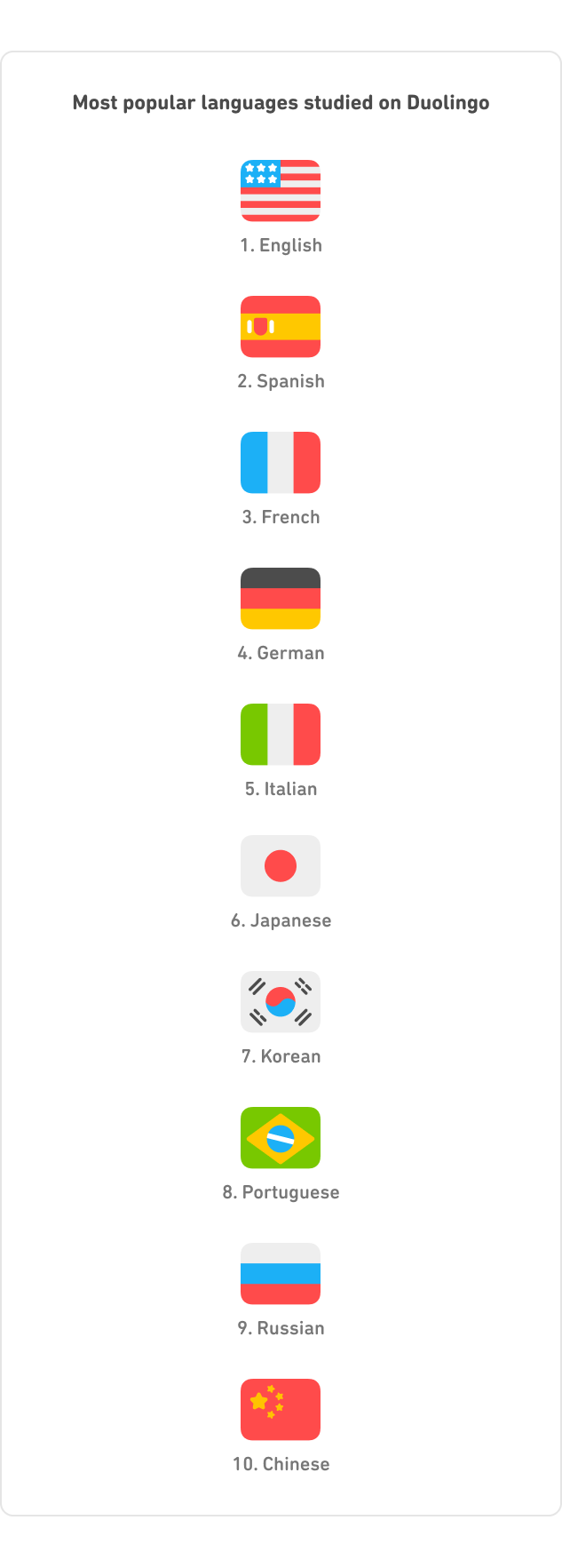
30 million new people take up language learning in the weeks after lockdown
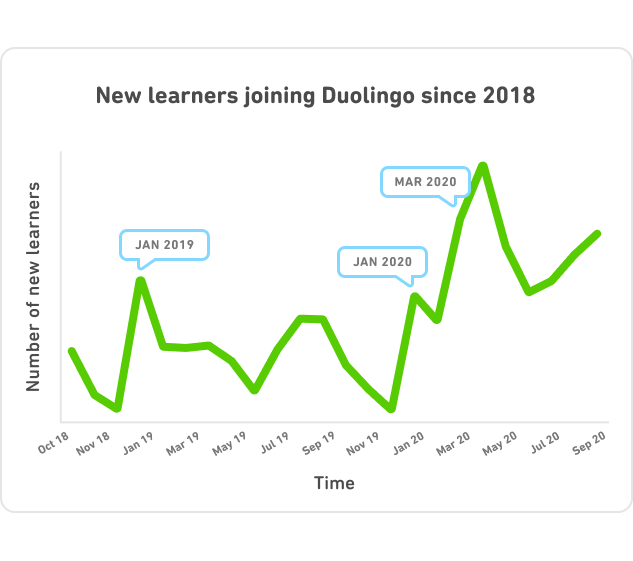
When we found ourselves suddenly without our commutes, schools, and social activities in March 2020, people around the world had to change their habits and daily routines overnight. In the weeks right after the World Health Organization announced that COVID-19 had become a global pandemic (March 11 - April 30), 30 million new learners began studying a language on Duolingo, which is 67% more new learners than during the same period in 2019. This incredible growth in language learning was far larger than typical New Year's spikes, when many learners are joining as part of their New Year's resolutions. Our global COVID spike was more than twice as large as our 2020 New Year's spike and more than 1.5 times as big as the 2019 New Year's spike.
Changes in language study around the world were closely linked to government policies, and especially to how clearly and decisively governments communicated them. This was already apparent immediately after lockdown: we saw significant increases in new learners right as each country announced its lockdown. China experienced the first wave of new learners when they locked down on February 20, and waves of new learners joined Duolingo each week as soon as a country implemented lockdown orders. For countries that delayed and wavered in making lockdown decisions, their learners were also less uniform in their response: some countries like Brazil experienced multiple, smaller spikes until lockdown protocols became clear and widely accepted. The magnitude of growth in language learning also varied by country, with Iraq topping the list with 640% growth in new learners during March/April 2020 compared to the same dates in 2019. China's enormous growth is also notable, especially because of how consistently learners continued to take up language learning long after their earlier lockdown on February 20: new learners in China grew more than 300% even weeks later, in March/April 2020.
Initially, new learners joined to supplement school classes, with 27.9% reporting school as their main motivation for studying a language, compared to 22.6% joining for school during March/April 2019. Brain training (15.9%) was a distant second among reasons for taking up language study during the lockdown. Unsurprisingly, travel didn't factor into learners' plans: although 19.9% of learners started studying a language for travel reasons in March/April 2019, only 12.7% of new learners were daydreaming of using their new language abroad during the first weeks of the 2020 lockdown.
English remains the most popular language to study; Spanish overtakes French as #2

English has long been the de facto lingua franca around the world, often used as a linguistic common denominator in tourism, government, science, and education in multilingual settings and communities. As a result, English remains the most popular language to study worldwide: English is the top language to study in 121 countries (62% of all countries), and it's the second-most popular in an additional eight countries. Proficiency in English is also related to economic and educational opportunities, and so we see that for many countries, their learners are uniformly committed to the study of English. For example, Yemen, Vietnam, the Dominican Republic, Burkina Faso, Saudi Arabia, and Guatemala top the list of English-learning countries, with between 70% and 80% of all learners studying English. Meanwhile, the countries with the smallest percentage of English learners all speak English as the official (or co-official) language: in Nigeria, Zimbabwe, Jamaica, the Philippines, and Botswana, fewer than 4% of learners study English.
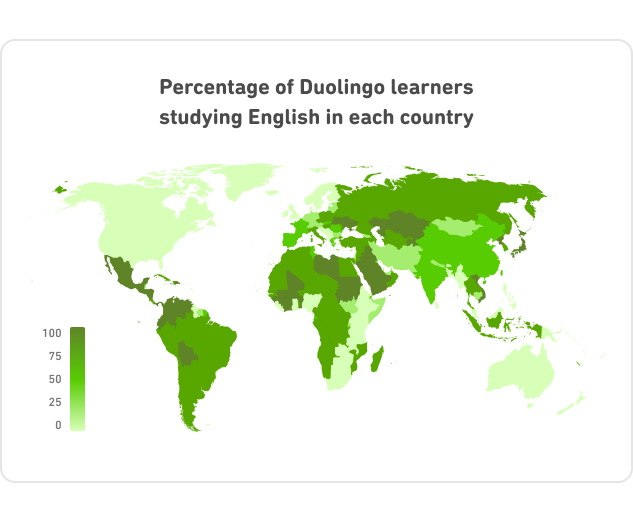
Spanish and French are the next most popular languages to study, but learners' relationships to these languages are evolving over time. French once dominated as the world's lingua franca, and in our 2016 analysis of language-learning trends, French was the top language to study in 35 countries, and Spanish was close behind with 32 countries. By 2020, however, Spanish has decisively overtaken French: today, Spanish is the most popular language to study in 34 countries, and French has dropped down to 23 countries. We can also see this pattern in the number of countries where each language is the second most popular to study; French (71 countries) and Spanish (70 countries) are neck and neck, and in the coming year Spanish may surpass French here as well.
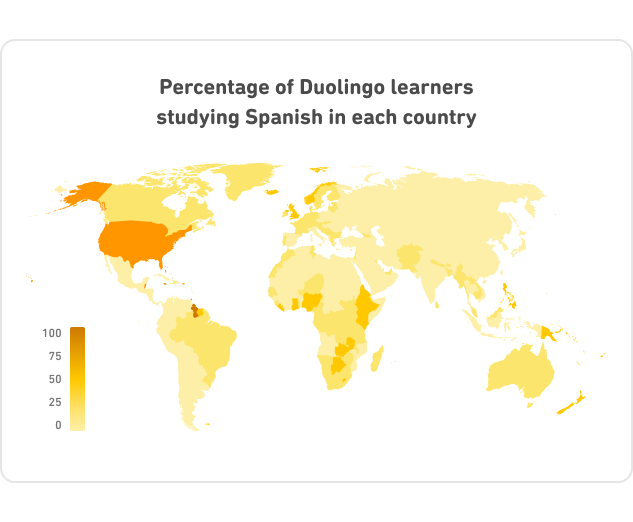
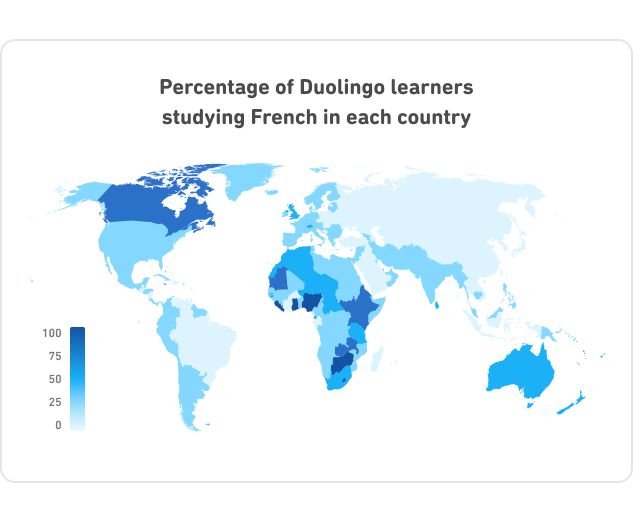
The rise of Spanish is likely linked to the movement of people between Latin America and other parts of the world for tourism, immigration, and education. It's become more important than ever, in more parts of the world than ever, to study Spanish and connect with Spanish-speaking communities.
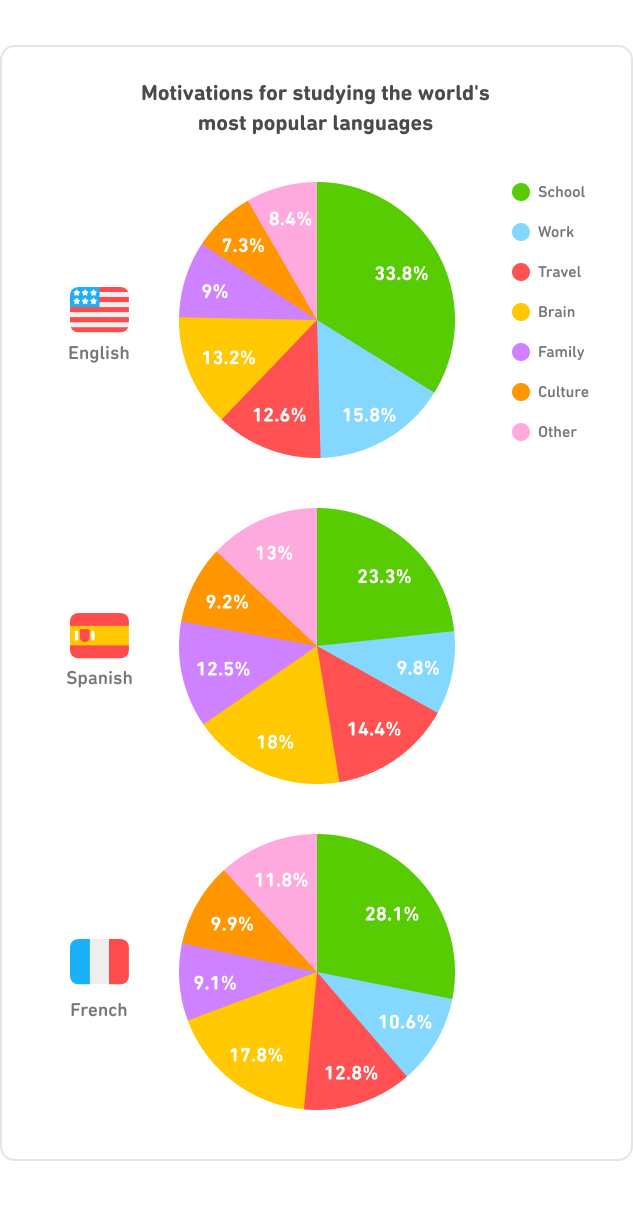
We can also see differences among the three top languages in why learners report studying them. School is a popular reason for all three, but it is a stronger motivator for English than for Spanish or French, with a full third of English learners studying for school. Work is the next most common reason for English, while Spanish and French learners are more likely to study for brain training.
Which countries study which languages?
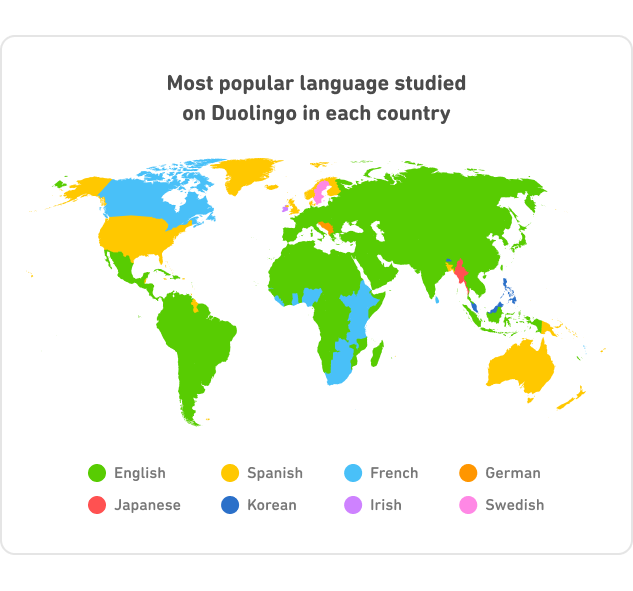
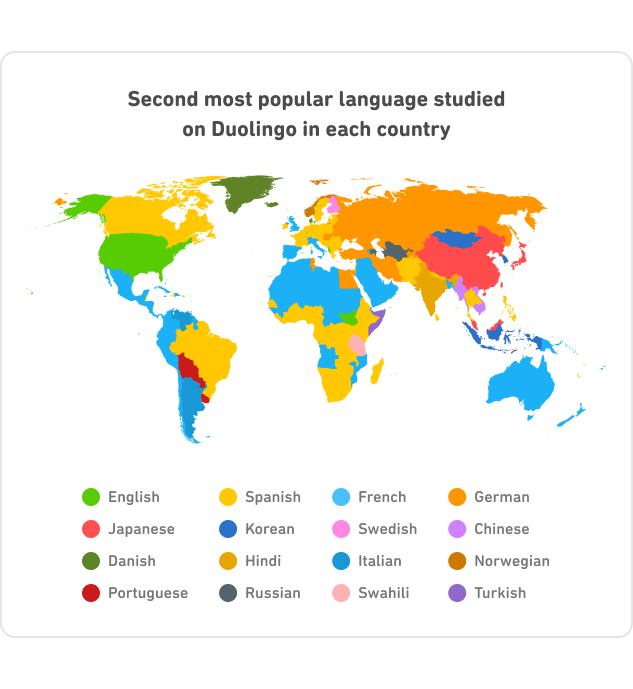
The top three languages studied around the world have remained stable in recent decades, but there has also been a global shift towards studying a wider range of languages. Compared to 2016, the top languages studied in each country now include more Asian languages and an endangered language, and one of the languages removed from the list is Italian. The list of second most popular languages is also notably longer: in 2016, this list included 9 languages, and today it includes 16! The 2020 list includes a number of European languages, as you might expect, but now also boasts 5 Asian languages (Japanese, Chinese, Korean, Hindi, Turkish) and an African language (Swahili).
The languages that countries and regions study around the world reflect colonization, immigration and economic opportunity, travel interests, and historical ties. These complex connections between people and languages are why French is especially popular in parts of Africa, why Swedish is the most popular language in Sweden and Danish is the second most popular in Denmark, and why German is studied throughout the Balkans.
Language study patterns are also influenced by pop culture, global events, and cultural trends, and so we can also see how current events change language study. For example, in our 2016 analysis, it appeared that Spanish-speaking countries in South America were particularly dedicated to Portuguese, presumably because of their Portuguese-speaking neighbor, Brazil. However, in 2019 and 2020, we see that Portuguese has dropped off the radar in South America. What happened? We suspect that the 2016 interest in Brazil's language was boosted by two important global events: the 2014 World Cup (hosted by Brazil) and the 2016 Summer Olympics in Rio de Janeiro. Now, years after the medals have been awarded, countries in South America have resumed their study of English and French. Will we see a surge of Japanese learners worldwide ahead of the 2021 Summer Olympics? Or will this Olympics boost be limited only to neighboring countries?
Here are some other notable language-learning trends from around the world:
- Japanese is now the 6th most popular language to study, with nearly as many people learning Japanese as there are learning Italian.
- Irish has soared to the top spot in Ireland, ousting Spanish as most popular language to study.
- We've known for years that Swedish is the most studied language in Sweden, but the other Scanidanivian countries also have especially large numbers of learners of their own languages: Danish ranks #2 in Denmark, and Norwegian is also #2 in Norway. We now know that in each case, half of these learners are studying their country's language for work or school. Immigrant communities in Scandinavia are especially committed to learning their country's language!
- The situation is different in Japan and Korea. In each of these countries, their own language is the second most popular to study, but travel is a bigger motivator than it is for the Scandinavian learners.
- In 2020, Brunei, Bhutan, Malaysia, and Myanmar are the only countries where English, Spanish, and French are not ranked in either of the top two spots. Since 2016, these Southeast Asian countries have moved towards studying Korean, Japanese, and Chinese more than the traditional top three.
- Some languages are more popular in their own country than they are anywhere else on earth! Here are the countries with the most learners within their own borders:
- Guaraní in Argentina (20% study for school and 19% for brain training)
- Finnish in Finland (20% study for family and another 20% for work)
- Indonesian in Indonesia (32% study for school and 22% for brain training)
- Catalan in Spain (31% study for school)
- Hawaiian in the U.S. (21% study for brain training and 18% for culture)
- Navajo in the U.S. (22% study for culture and 21% for brain training)
World is learning more Asian languages
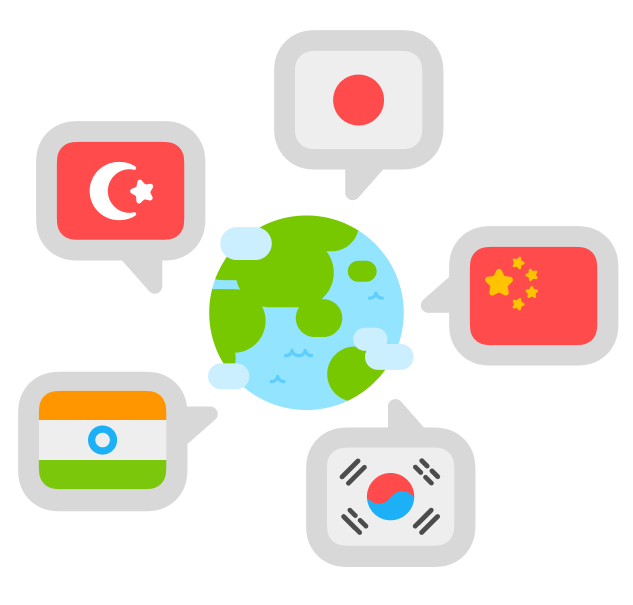
All five of the fastest growing languages around the world are Asian languages! While the languages themselves are extremely linguistically diverse (all five come from completely different language "families"), what they have in common is that they are spoken by communities that have a growing presence in media and pop culture worldwide.
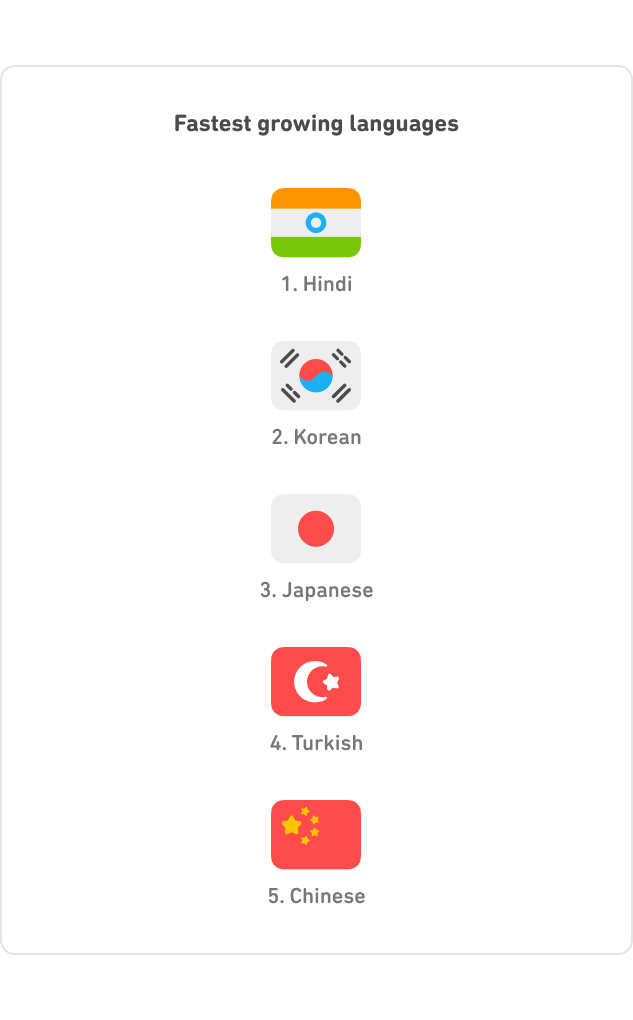
Hindi is the newest Duolingo course on this list, so it's too early to tell whether it'll be able to hold on to its top spot or what is driving new learners to try out Hindi. Korean and Japanese are the superstars on this list and have rocked the language-learning charts around the world since they were introduced on Duolingo in 2017.
Korean, the second fastest growing language in the world, is ranked worldwide at #7 for most popular language to study. In 2019, Korean was already the most popular language in one country (Brunei), and this year Korean's popularity has boosted it to #1 in Bhutan, Malaysia, and the Philippines, in addition to Brunei. The largest number of Korean learners can be found in the U.S., China, India, the Philippines, and Indonesia. We can also see the reach of Korean's appeal in the countries where it's growing the fastest, which include a diverse group throughout Asia and Africa: China, Sierra Leone, Ethiopia, Bhutan, and India! The impressive growth in Korean learners around the world can be attributed to similarly rapid growth in worldwide interest in Korean culture and media, including K-pop, drama series, and movies.
Japanese has earned #3 on the list of fastest growing languages in the world, and it's ranked #6 worldwide among the most popular languages to study. Last year, Japanese broke onto the list of most popular languages to study, ranking #1 in Myanmar, and this year, Singapore and Micronesia have joined the list of countries where Japanese is the top language. Whereas the top countries studying Korean are concentrated in Asia (in addition to the U.S.), the largest numbers of Japanese learners include more English-speaking countries in the west: the U.S. tops the list, followed by China, the U.K., India, and Canada. But just like Korean, the countries with most growth in Japanese include learners throughout Africa and Asia! The biggest growth in Japanese is seen in China, Chad, Bhutan, the Seychelles, and Ethiopia. Also like Korean, global interest in Japanese culture, including manga and anime is likely responsible for the sustained and significant growth in Japanese learners around the world.
The meteoric rises of Asian languages indicate that global interest in these languages and their cultures is more than a passing fad. While English, Spanish, and French might be comfortably at the top of the list in 2020, language learning trends are changing fast: Korean jumped two places this year (in 2019, it was #9), and Chinese is set to overtake Russian for the #9 spot by the end of next year.
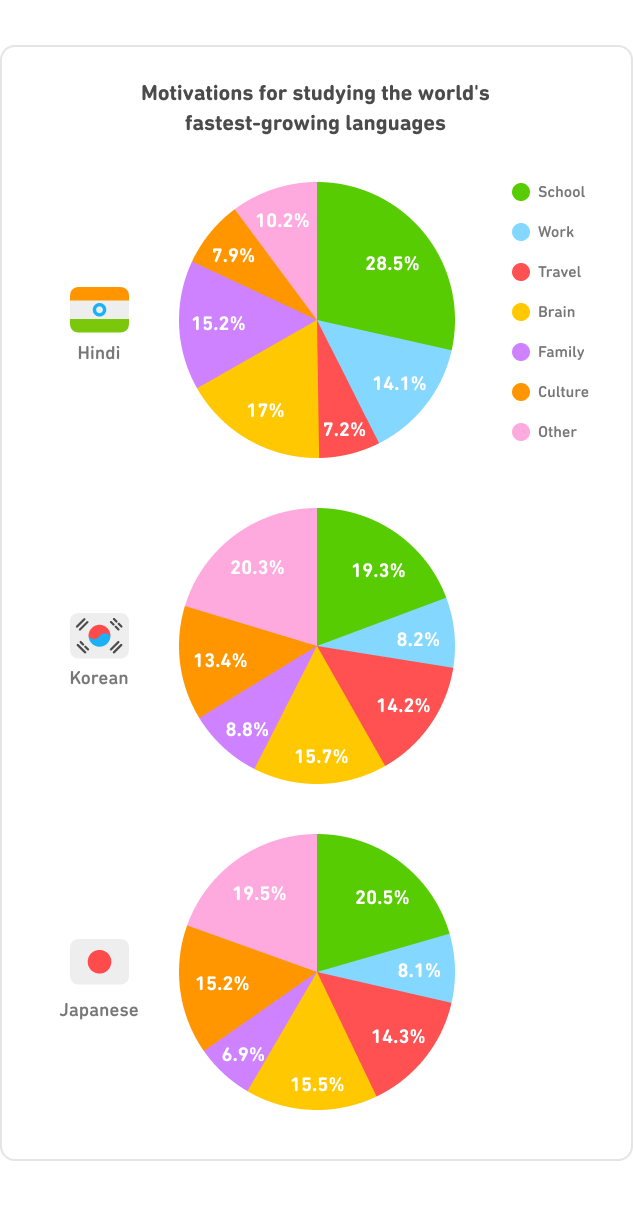
Learners' motivations indicate that school is the most important factor in studying these Asian languages, followed by brain training. Travel and culture have been important motivators for Korean and Japanese learners--further evidence of the pull of K-pop and the entertainment industry on language-learning patterns. On the other hand, students of Hindi are more likely to report studying the language for family reasons.
How do study habits differ around the world?
No matter what language you're studying or why, becoming a confident, proficient user of the language takes persistence! The hardest-working countries around the world complete the most lessons per learner, and this year Germany edged out Japan for the honor of the country with the hardest-working learners.
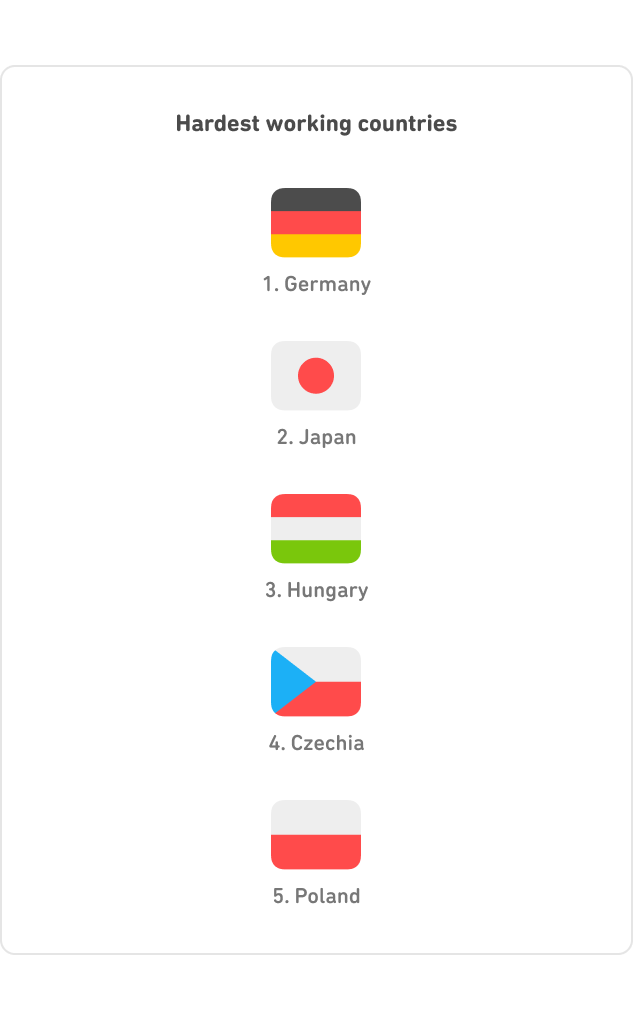
Interestingly, many of the hardest-working countries are also the most dedicated countries: they have the longest streaks on Duolingo, coming back regularly, without fail, for long periods of time. Hungary tops the list of most dedicated countries, followed by Japan at #2 and Germany at #3.
It's clear that learners in Japan, Germany, and Hungary are especially accomplished--both hard-working and dedicated--but not all learners do so well for both traits! Check out our country reports to learn which regions are dabblers (very dedicated, but only do a little at a time) and which are binge-learners (completing lots of lessons, but for shorter bursts of study time).
Learners are far more consistent when it comes to when they like to study: evening is by far the most popular time for language study, with half of all countries being the most active from 10-11pm and another 41.6% of countries studying a bit earlier, between 9-10pm. However, there are five countries that follow a very different schedule: learners in Monaco study the most between 5-6pm, followed by France at 6-7pm, and then Barbados, Dominica, and Spain studying at 7-8pm. These exceptions likely reflect larger schedule differences for these learners, who may be eating lunch and dinner later than in other countries and so have early evening hours available for language study.
In-depth analysis of language trends around the world
For more information about 2020 language-learning trends worldwide, check out these reports!
 U.S. report
U.S. report
|
 U.K. report
U.K. report
|
 Mexico report
Mexico report
|
 Brazil report
Brazil report
|
 China report
China report
|
 Japan report
Japan report
|
You can also explore a subset of our 2020 data, which we have made available to the public here.
About the data
The 2020 Duolingo Language Report includes information about learners who studied languages on Duolingo between October 1, 2019 and September 30, 2020. The data was aggregated by country or by language to ensure learner privacy. Country aggregations are based on internationally-recognized, independent, self-governing entities as outlined here. Also to the end of protecting learner privacy, rankings exclude countries where there are fewer than 5000 Duolingo learners.
Português: Relatório de Idiomas Duolingo 2020
Tendências de aprendizado de idiomas em um ano totalmente imprevisível
Prefácio por Luis von Ahn
Nós criamos o Duolingo em 2011 com a missão de desenvolver a melhor educação do mundo e torná-la acessível a todos. Eu sempre achei que a desigualdade econômica é um dos maiores problemas que assolam a humanidade, e a educação é a melhor forma de ajudar a maior parte das pessoas a melhorar as suas vidas. A nossa visão é criar um mundo onde mais dinheiro não pode comprar uma educação melhor.
Nos últimos nove anos, o Duolingo se tornou a forma mais popular de aprender um idioma e o aplicativo de educação mais baixado do planeta. O nosso método nos permitiu atingir proporções enormes, com mais de 500 milhões de usuários no total e cerca de 40 milhões de usuários ativos por mês, que representam todos os países do mundo. Somos uma companhia movida por evidências: testamos e medimos tudo que fazemos, e usamos estes dados para melhorar o nosso ensino de forma constante. Como resultado disso, temos mais conhecimento das tendências de aprendizagem de idiomas do que qualquer outra entidade na história humana.
Por que deveríamos nos importar com estas tendências e o que podemos aprender com elas? Os idiomas que os países e regiões estudam pelo mundo refletem o nosso histórico passado e a nossa cultura presente, e podem trazer pistas dos próximos rumos da nossa sociedade global. As tendências nos nossos dados representam os efeitos da colonização, imigração, economia e cultura. Estes fatores aparecem nas tendências mais importantes de 2020.
Enquanto o inglês se mantém como o idioma mais estudado pelo mundo, o segundo idioma mais popular indica uma tendência importante. Este ano, vimos o espanhol ultrapassar o francês como o segundo idioma estudado em mais países do que nunca. Num ano em que um filme coreano ganhou o Oscar de melhor filme e as Olimpíadas seriam sediadas no Japão, também observamos um aumento no estudo de idiomas asiáticos. A influência cultural da América Latina e da Ásia no resto do mundo não para de crescer!
Porém, não há nenhuma tendência no ano maior do que o impacto da covid-19. A pandemia que transformou praticamente todos os aspectos da vida cotidiana também afetou o aprendizado de idiomas. Conforme as medidas de isolamento social foram tomadas, os estudos de idiomas cresceram pelo mundo, muitas vezes em sintonia com as ações dos governos. Mais de 30 milhões de pessoas começaram a aprender um idioma no Duolingo nas semanas após o surto da pandemia. Mas as motivações para o aprendizado e os idiomas que elas escolhem aprender têm mudado. O Relatório de Idiomas Duolingo a seguir reúne os nossos esforços em compartilhar o nosso ponto de vista singular com o resto do planeta.
Sumário
- 30 milhões de pessoas começaram a aprender idiomas nas primeiras semanas após o lockdown
- O inglês ainda é o idioma mais popular; o espanhol ultrapassou o francês na segunda posição
- Quais países estudam quais idiomas?
- O mundo está cada vez mais interessado nos idiomas asiáticos
- Como os hábitos de estudo variam ao redor do mundo?
- Análise aprofundada das tendências de idiomas ao redor do mundo
O Relatório de Idiomas Duolingo 2020 inclui tendências, padrões e análises sobre o aprendizado de idiomas pelo mundo todo. Os nossos dados refletem como esse aprendizado se deu com a amostra mais abrangente que já coletamos: o Duolingo tem mais de 500 milhões de estudantes em todos os 194 países, é gratuito e está disponível como um site e um aplicativo móvel para que pessoas de todas as origens e perfis usem a nossa plataforma. Além disso, oferecemos 98 cursos que ensinam 39 idiomas diferentes. Os nossos cursos incluem idiomas de todos os continentes, idiomas ameaçados de extinção, idiomas indígenas, dois idiomas ficcionais, um idioma clássico e 22 cursos de inglês, cada um deles para falantes nativos de diferentes línguas. Este relatório investiga quais países estudam quais idiomas, como esse interesse mudou com o tempo (especialmente desde a nossa análise de 2016 e com o efeito da pandemia global deste ano) e como o comportamento das pessoas varia pelo mundo.
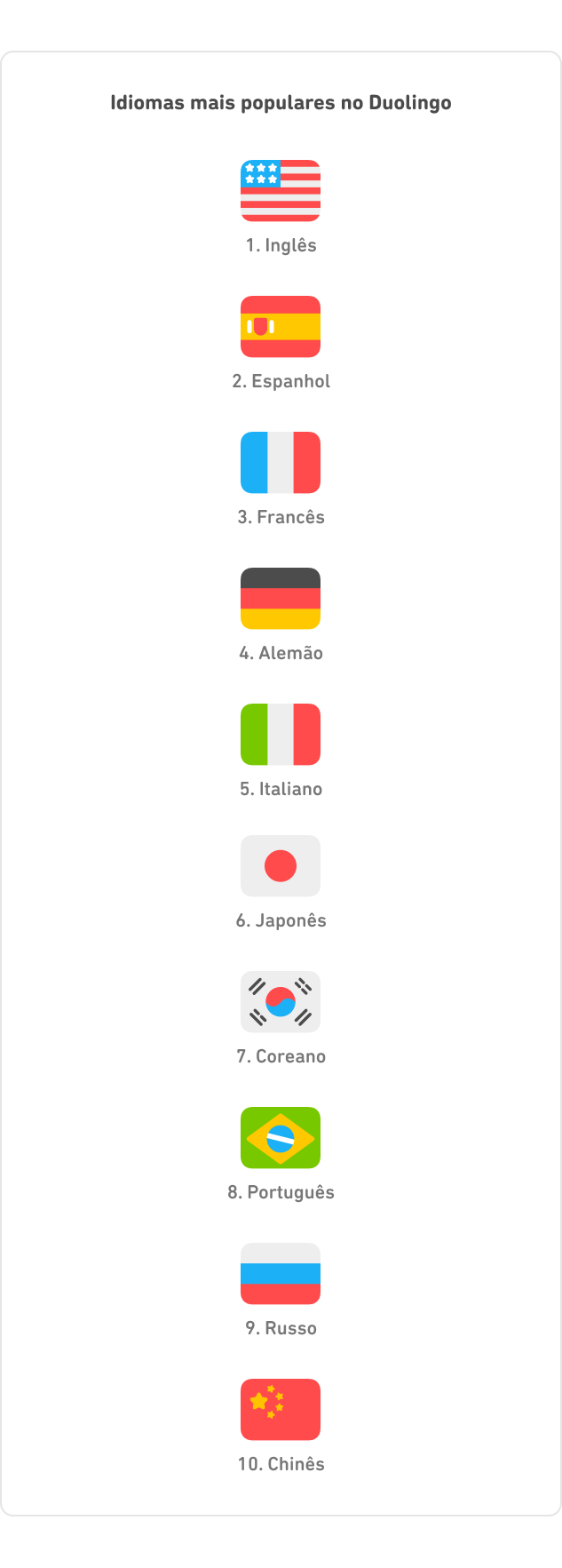
30 milhões de pessoas começaram a aprender idiomas nas primeiras semanas após o lockdown
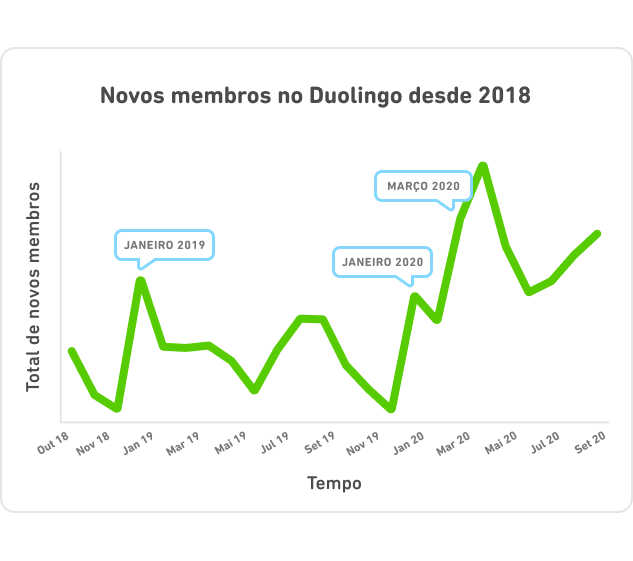
Em março de 2020, quando de repente nos vimos sem as nossas rotinas, escolas e atividades sociais, pessoas do mundo todo tiveram que mudar os seus hábitos de um dia para o outro. Nas semanas logo após a Organização Mundial de Saúde anunciar que a covid-19 havia se tornado uma pandemia global (11 de março a 30 de abril), 30 milhões de novos estudantes começaram a aprender um idioma no Duolingo – 67% a mais do que no mesmo período em 2019. Esse crescimento incrível foi muito maior do que os picos típicos de Ano-Novo, quando muitas pessoas criam contas como parte das suas resoluções para o ciclo que começa. O nosso pico global da covid foi maior que o dobro do pico do Ano-Novo de 2020 e pelo menos 50% maior que o pico do Ano-Novo de 2019.
As mudanças no estudo de idiomas ao redor do mundo estiveram fortemente ligadas às políticas de cada governo e especialmente à clareza e firmeza com que elas foram comunicadas. Isso se tornou perceptível imediatamente após o lockdown: vimos aumentos significativos do número de novos membros assim que cada país anunciou as suas restrições. A China teve o seu primeiro pico de novos membros quando se fechou em 20 de fevereiro, e ondas de novos membros chegaram ao Duolingo toda semana em que um país implementou medidas de isolamento social. Nos países que hesitaram e adiaram a decisão, as pessoas também foram menos uniformes nas suas respostas: alguns países, como o Brasil, tiveram picos menores e mais numerosos até que os protocolos de lockdown se tornassem claros e fossem aceitos pela população. A magnitude do crescimento no aprendizado de idiomas também mostrou variação por país, com o Iraque na liderança com crescimento de 640% em novos membros em março/abril de 2020 em comparação ao mesmo período de 2019. Também vale destacar o enorme crescimento da China, especialmente porque os novos membros continuaram a aparecer de forma consistente, mesmo bastante tempo depois do seu lockdown, que começou em 20 de fevereiro. Semanas depois, em março/abril de 2020, os membros daquele país cresceram mais de 300%.
Inicialmente, os novos membros do mundo todo buscavam um complemento às aulas formais: 27,9% indicavam "estudos" como a sua maior motivação para aprender um idioma, em comparação a 22,6% em março/abril de 2019. "Exercício mental" (15,9%) chegou em um segundo lugar bem distante entre as razões para se estudar um idioma durante o isolamento. Conforme o esperado, "viagens" perdeu importância: enquanto 19,9% dos novos membros começaram a estudar para viajar em março/abril de 2019, apenas 12,7% dos novos membros de 2020 sonhavam em usar o seu novo idioma no exterior durante as primeiras semanas do lockdown.
O inglês ainda é o idioma mais popular; o espanhol ultrapassou o francês na segunda posição

Há muito tempo o inglês já funciona na prática como uma língua franca, frequentemente usado como um denominador comum em ambientes multilíngues no turismo, no governo, na ciência e na educação. Como resultado, o inglês ainda é o idioma mais popular no mundo todo: é o primeiro mais estudado em 121 países (62% de todos os existentes) e o segundo em outros oito. A proficiência em inglês também está relacionada a oportunidades econômicas e educacionais, e é isso que vemos em muitos países cujos habitantes se dedicam ao estudo de inglês de forma consistente. Por exemplo, Iêmen, Vietnã, República Dominicana, Burkina Faso, Arábia Saudita e Guatemala lideram a lista dos países que aprendem inglês: nesses lugares, cerca de 70% a 80% das pessoas que estudam idiomas optaram por este curso. Enquanto isso, os países com a menor taxa de estudantes de inglês já o têm como o seu idioma oficial (ou um dos seus idiomas oficiais): Nigéria, Zimbábue, Jamaica, Filipinas e Botsuana, locais onde menos de 4% das pessoas estudam essa língua.
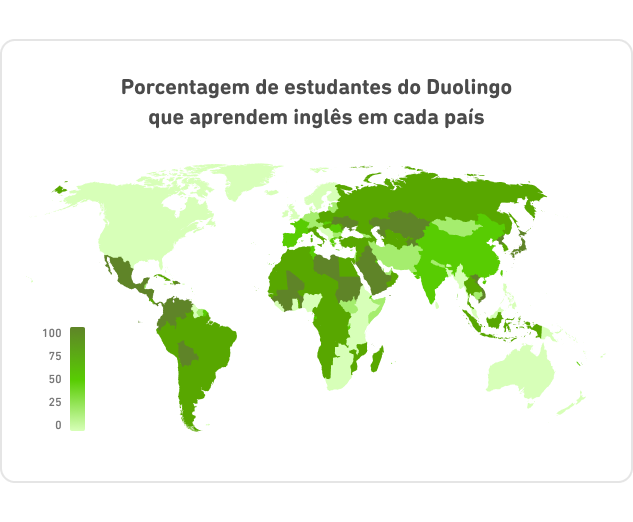
O espanhol e o francês ocupam as próximas posições na lista de idiomas mais populares, mas o relacionamento dos estudantes com eles está em processo de mudança. O francês já teve o seu reinado como língua franca mundial e, na nossa análise de 2016 das tendências de aprendizado de idiomas, ele foi o mais estudado em 35 países, enquanto o espanhol veio logo atrás, com 32 países. Contudo, em 2020, o espanhol decididamente ultrapassou o francês: hoje, o espanhol é o idioma mais estudado em 34 países, e o francês caiu para 23. Também vemos esse padrão no número de países que têm algum desses idiomas como o segundo mais popular: o francês (71 países) e o espanhol (70 países) estão quase empatados, e pode ser que no ano que vem o espanhol supere o francês em mais esse quesito.
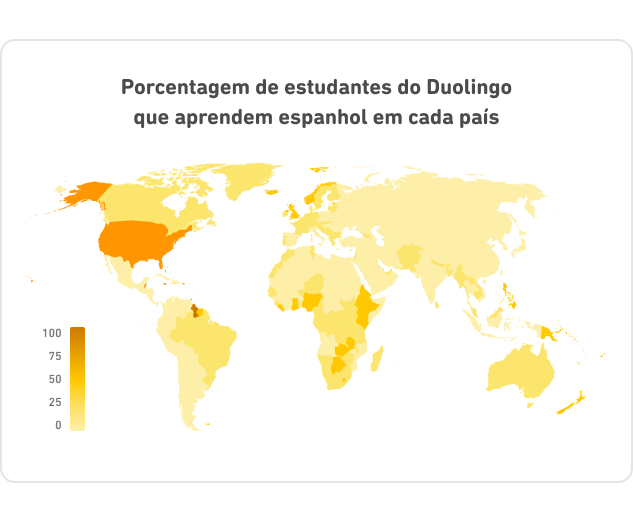
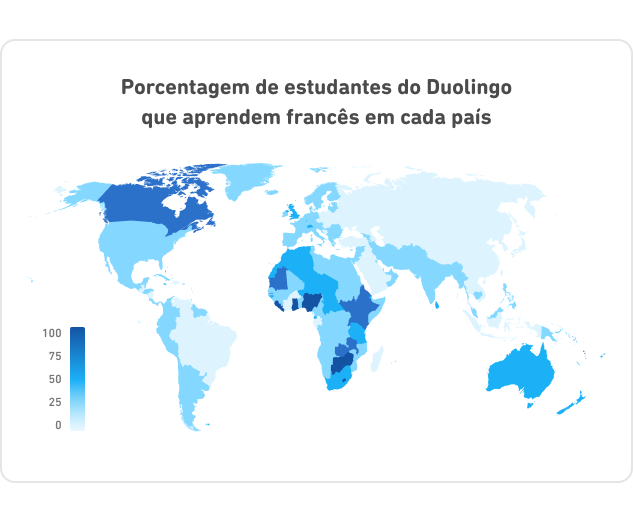
A ascensão do espanhol provavelmente tem ligação com a movimentação de pessoas entre os países latino-americanos e outras partes do mundo para fins de turismo, imigração e educação.
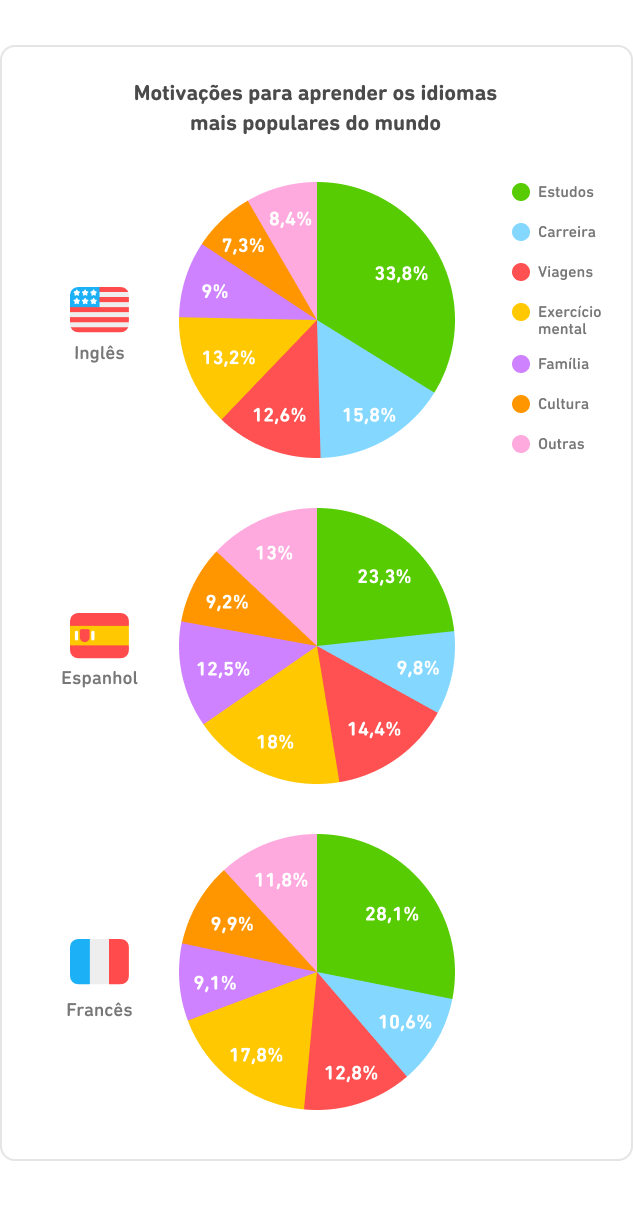
Também vemos diferenças nos motivos pelos quais as pessoas aprendem esses três idiomas. Os estudos são uma razão popular para todos, mas aparecem com mais força para o inglês do que para o espanhol ou o francês – tanto que um terço de todos os estudantes de inglês apontam essa motivação. O trabalho é a próxima razão mais citada para o inglês, enquanto as pessoas que aprendem espanhol e francês fazem isso mais pelo exercício mental.
Quais países estudam quais idiomas?
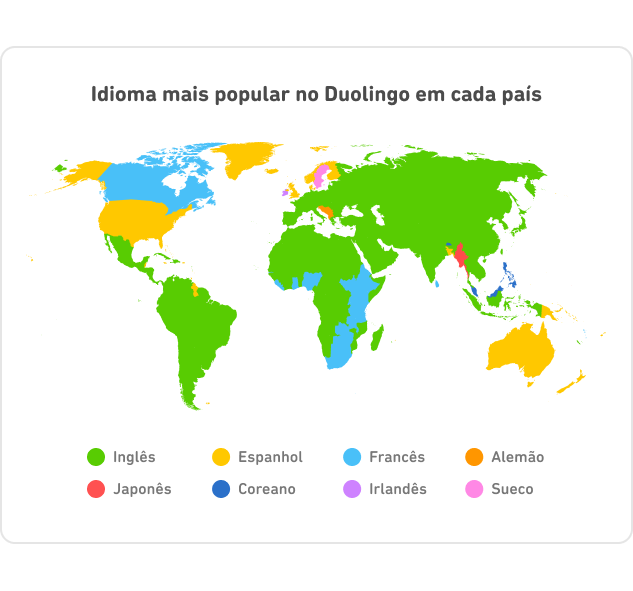
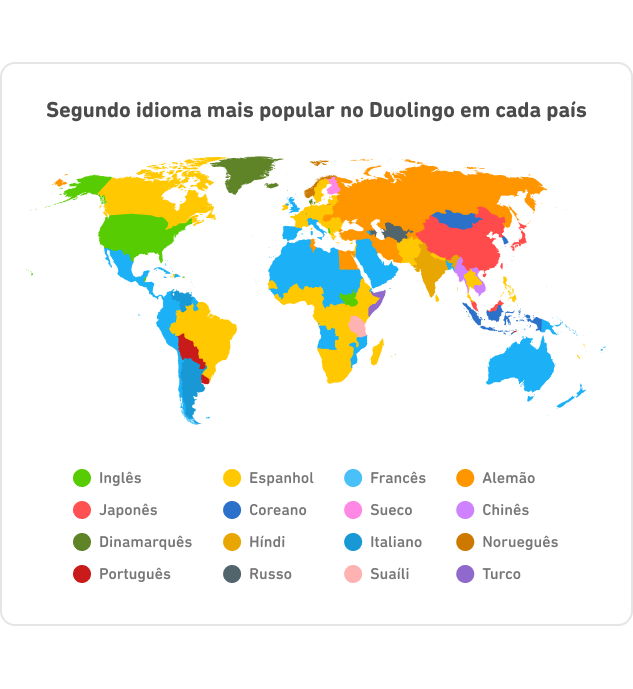
Os três idiomas mais estudados do mundo têm se mantido estáveis nas últimas décadas, mas também temos visto mudanças que ampliam esse leque. Em comparação a 2016, os idiomas mais estudados em cada país agora incluem mais línguas asiáticas e línguas ameaçadas de extinção, e o italiano saiu desse grupo. A lista dos segundos idiomas mais populares do mundo também ficou visivelmente mais longa: em 2016 ela incluía nove, e hoje inclui 16! A lista de 2020 inclui idiomas europeus, como seria esperado, mas agora também contém cinco asiáticos (japonês, chinês, coreano, híndi, turco) e um africano (suaíli).
Os idiomas que os países e regiões estudam pelo mundo refletem interesses turísticos, tendências migratórias e oportunidades econômicas, mas também retratam laços históricos e de colonização. Essas relações complexas entre pessoas e línguas explicam por que o francês continua especialmente popular em partes da África, que o sueco se mantém como o primeiro idioma mais popular da Suécia, que o dinamarquês continua a ser o segundo mais popular da Dinamarca e que o alemão ainda é estudado nos Bálcãs.
Os padrões nos estudos de idiomas também são influenciados pela cultura pop, pelos eventos globais e pelas tendências culturais, e por isso podemos ver como eles são afetados por acontecimentos recentes. Por exemplo, a nossa análise de 2016 mostrou que os países sul-americanos falantes de espanhol estavam particularmente dedicados ao português, possivelmente por causa do seu vizinho que é nativo deste idioma, o Brasil. Porém, em 2019 e 2020, vemos que o português saiu do radar na América do Sul. O que aconteceu? Suspeitamos que o aumento do interesse no idioma que aconteceu em 2016 tenha sido alimentado por dois importantes eventos globais: a Copa do Mundo de 2014, que foi sediada no país, e as Olimpíadas de 2016 no Rio de Janeiro. Uma vez encerradas as competições, esses países voltaram aos seus estudos de inglês e francês. Será que veremos um crescimento no número de estudantes de japonês pelo mundo às vésperas das Olimpíadas de 2021? Ou será que esse boom olímpico vai se limitar aos países vizinhos?
Mais algumas tendências interessantes do aprendizado de idiomas pelo mundo:
- O japonês agora é o sexto idioma mais estudado, com quase tantos estudantes quanto o italiano;
- O irlandês ganhou a liderança na Irlanda e superou o espanhol como o idioma mais popular do país;
- Há anos, já sabemos que o sueco é o idioma mais estudado da Suécia, mas os outros países escandinavos também têm números elevados de estudantes nos seus próprios idiomas: o dinamarquês está em segundo lugar na Dinamarca, e o norueguês também está em segundo lugar na Noruega. Sabemos que, em ambos os casos, metade dessas pessoas aprende o idioma do seu país para o trabalho ou os estudos. As comunidades de imigrantes da Escandinávia se dedicam muito a aprender o idioma da sua nova pátria!
- O cenário é outro no Japão e na Coreia. Esses lugares também têm o próprio idioma como o segundo mais popular, mas as viagens são uma motivação maior do que para os escandinavos.
- Este ano, Brunei, Butão, Malásia e Mianmar são os únicos países onde o inglês, o espanhol e o francês não estão entre os dois idiomas mais estudados. Desde 2016, estes países sul-asiáticos se voltam mais para o estudo do coreano, japonês e chinês do que para os três mais tradicionais.
- Alguns idiomas são mais populares no seu próprio país do que em qualquer outro lugar do mundo:
- O guarani na Argentina (20% aprendem para os estudos e 19% como exercício mental);
- O finlandês na Finlândia (20% estudam para se conectar com familiares e outros 20% para o trabalho);
- O indonésio na Indonésia (32% aprendem para os estudos e 22% como exercício mental);
- O catalão na Espanha (31% aprendem para os estudos);
- O havaiano nos EUA (21% estudam como exercício mental e 18% em função da cultura);
- O navajo também nos EUA (22% estudam em função da cultura e 21% como exercício mental).
O mundo está cada vez mais interessado nos idiomas asiáticos
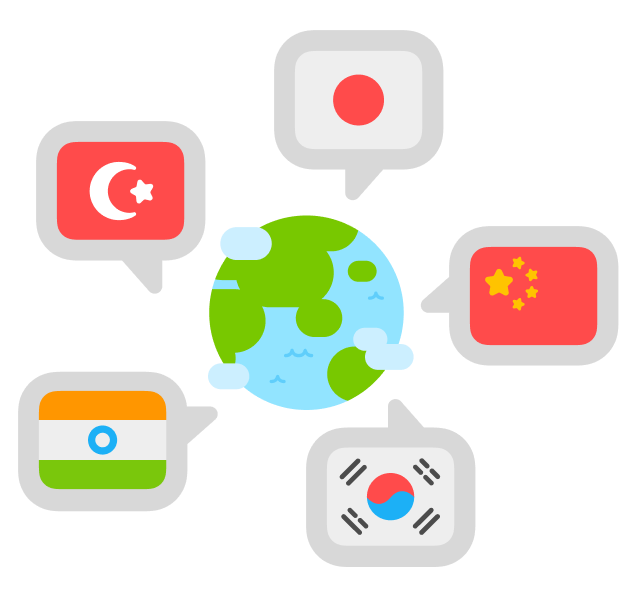
Todos os cinco idiomas com o crescimento mais rápido no mundo são asiáticos! Eles são extremamente diversos linguisticamente (pois vêm de "famílias" linguísticas completamente distintas), mas o que eles têm em comum é que são falados por comunidades que estão cada vez mais presentes na mídia e na cultura popular no mundo todo.
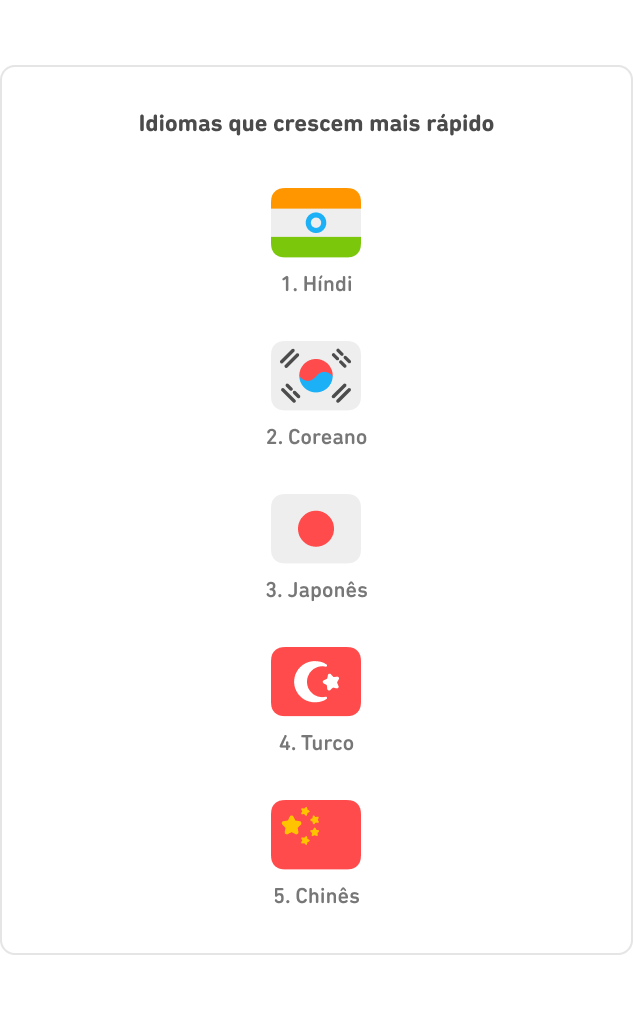
O híndi é o curso mais novo do Duolingo a entrar na lista; por isso, ainda é um pouco cedo para saber se ele vai conseguir manter o seu posto ou para determinar o que motiva os novos estudantes a experimentar esse idioma. O coreano e o japonês são as duas grandes estrelas desta lista, e eles abalaram as estruturas do aprendizado de idiomas pelo mundo desde que chegaram ao Duolingo em 2017.
O coreano é o segundo idioma que cresce mais rápido no planeta e ocupa o sétimo lugar entre as línguas mais estudadas. Em 2019, o coreano já era o idioma mais popular em um país (Brunei), e este ano a sua popularidade decolou para o primeiro lugar também no Butão, na Malásia e nas Filipinas, além de manter esta posição em Brunei. O maior número de estudantes de coreano pode ser encontrado nos EUA, na China, na Índia, nas Filipinas e na Indonésia. Também podemos ver o alcance do interesse no idioma ao olhar para os países onde ele cresce mais rápido, os quais englobam um grupo diverso que se estende ao longo da Ásia e da África: China, Serra Leoa, Etiópia, Butão e Índia! O crescimento impressionante do número de estudantes coreanos pelo mundo pode ser atribuído ao crescimento igualmente impressionante do interesse mundial pela cultura e mídia coreanas, que incluem o K-pop, séries dramáticas e filmes.
O japonês conquistou o terceiro lugar na lista dos idiomas com crescimento mais rápido e é o sexto mais estudado no mundo. Ano passado, o japonês estreou na lista das línguas mais populares, com o primeiro lugar em Mianmar; este ano, Cingapura e Micronésia se juntaram ao grupo de países onde o japonês é o idioma principal. Enquanto os países que mais estudam coreano se concentram na Ásia (além dos Estados Unidos), o maior número de estudantes de japonês inclui mais falantes de inglês do ocidente: os EUA encabeçam a lista, seguidos por China, Reino Unido, Índia e Canadá. Porém, como no caso do coreano, os países onde o japonês mais cresceu estão na África e na Ásia! O maior crescimento foi visto na China, no Chade, no Butão, nas Seicheles e na Etiópia. E, assim como acontece com a Coreia, o interesse global na cultura do Japão, que inclui o mangá e o anime, provavelmente é o responsável pelo crescimento consistente e significativo do número de estudantes de japonês pelo mundo.
O crescimento meteórico dos idiomas asiáticos indica que o interesse nesses idiomas e nas suas culturas não é uma moda passageira. O inglês, o espanhol e o francês podem estar confortáveis no topo da lista em 2020, mas as tendências de aprendizado mudam rápido: o coreano subiu duas posições este ano (ele estava em nono lugar em 2019), e o chinês deve ultrapassar o russo na nona posição até o final do ano que vem.
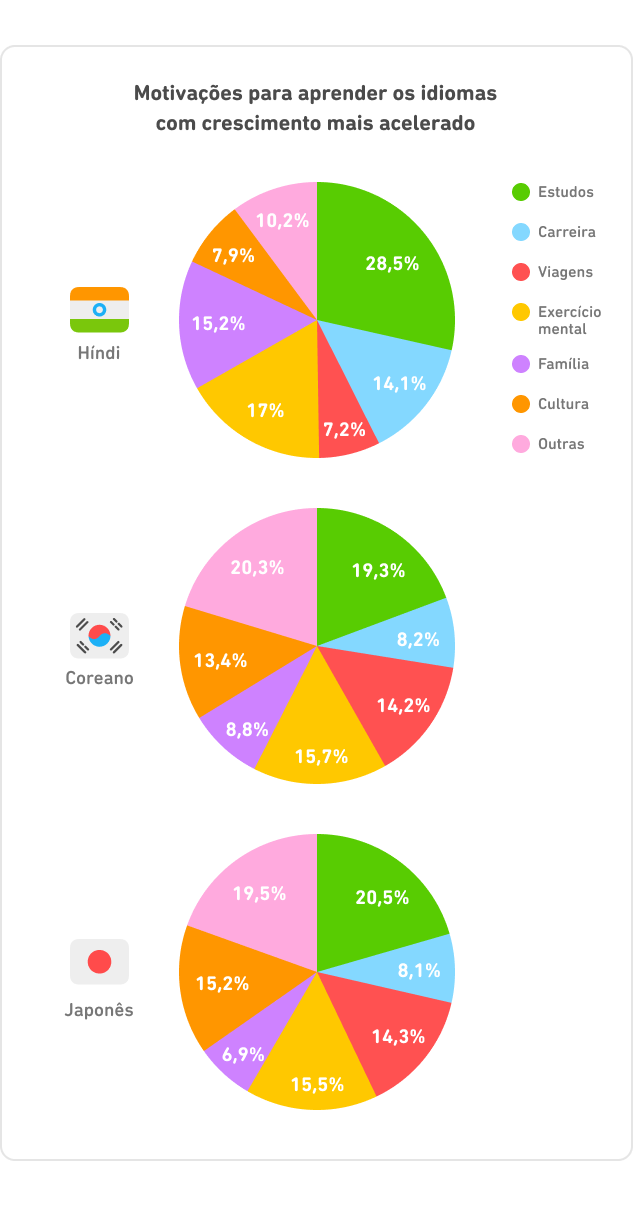
As motivações dos usuários indicam que os estudos são o fator mais importante no aprendizado desses idiomas asiáticos, seguidos pelo exercício mental. Viagens e cultura têm sido importantes motivadores para quem aprende coreano e japonês – o que sinaliza ainda mais a força do K-pop e da indústria de entretenimento nos padrões de aprendizado. Por outro lado, os estudantes de híndi são os que mais relatam estudar a língua para reforçar os laços com os seus familiares.
Como os hábitos de estudo variam ao redor do mundo?
Independentemente do que você estuda e dos seus motivos para isso, alcançar confiança e proficiência no uso de um idioma exige dedicação! Os países mais ativos no Duolingo são os que completam o maior número de lições por estudante. Este ano, a Alemanha superou o Japão na disputa desse título.
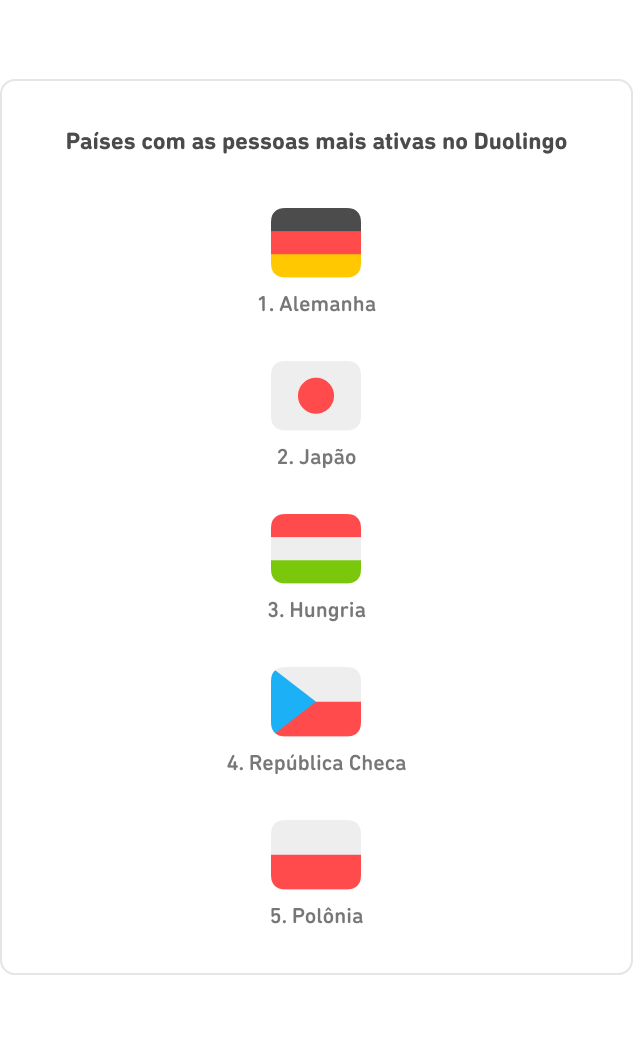
É interessante que muitos dos países mais ativos também são os mais persistentes: eles têm as maiores ofensivas do Duolingo e estudam regularmente, sem falta, por longos períodos. A Hungria lidera a lista dos países mais persistentes, seguida pelo Japão no segundo lugar e pela Alemanha no terceiro.
É evidente que os estudantes do Japão, da Alemanha e da Hungria são especialmente brilhantes – ativos e persistentes –, mas nem todos os estudantes vão bem em ambos os quesitos! Confira os relatórios de cada país para ver quais regiões são casuais (muito dedicadas, mas fazem poucas lições por vez) e quais são maratonistas (têm menos “picos” de estudo, mas fazem muitas lições de uma vez só).
Os estudantes são bem mais consistentes em relação a quando eles gostam de estudar. As noites são de longe o horário mais popular para os idiomas: quase 50% dos países ficam ativos das 22h às 23h, e outros 41,6% estudam um pouco mais cedo, das 21h às 22h. Entretanto, há cinco países que seguem um cronograma bem diferente: os usuários do Duolingo de Mônaco estudam mais das 17h às 18h, seguidos pelos da França, das 18h às 19h, e, depois, pelos de Barbados, Dominica e Espanha, que estudam das 19h às 20h. Esses casos provavelmente refletem diferenças de horário ainda maiores para essas pessoas, que talvez almocem ou jantem mais tarde que os habitantes de outros países e tenham o começo da noite disponível para praticar os seus idiomas.
Você também pode explorar uma parte dos nossos dados de 2020 – ela está disponível para o público aqui.
Sobre os dados
O Relatório de Idiomas do Duolingo de 2020 inclui informações sobre pessoas que estudaram idiomas no Duolingo entre 1º de outubro de 2019 e 30 de setembro de 2020. Os dados foram agrupados por país ou por idioma para garantir a privacidade dos nossos usuários. Os agrupamentos por país são realizados com base em entidades autônomas, independentes e reconhecidas internacionalmente conforme detalhado aqui. Para proteger a privacidade dos nossos usuários, os rankings excluem países com menos de 5.000 estudantes no Duolingo.
中文: 2020 年语言学习趋势报告
来看看这与众不同的一年里,语言学习的趋势如何?
Luis von Ahn 的序言
多邻国在 2011 年创立,使命是把优质平等的教育带到世界上每一个角落。我一直认为,经济不平等是人类面临的最大挑战之一,而教育则是帮助世界上大多数人提高生活水平的最佳途径。我们的愿景是为世界创造不能以更多金钱换取的优质教育。
在过去的九年里,多邻国不但成为了全球最火的语言学习方式,也是世界上下载次数最多的教育应用程序。在我们的发展方针下,多邻国实现了巨幅增长:现在已有超过 5 亿的用户,遍布全球每一个国家及地区,每月活跃用户量约 4000 万。多邻国是一家以数据为主导的公司。在这里,我们所做的一切都要经过测试和衡量,我们会依据所得数据不断改良多邻国的教学方式。因此,我们相信多邻国是有史以来对全球语言学习趋势掌握最透彻精准的公司。
为什么要关注全球的语言学习趋势?我们又能从中学到什么?各个国家和地区所学习的语言不仅能反映出我们过往的历史和现行文化,还有可能为全球社会的走向提供参考。我们的数据中呈现的趋势,体现了殖民、移民、经济和文化的影响,而这些因素在 2020 年的重要趋势中都有所表现。
英语一直是全球最受欢迎的语言,但排名第 2 的语言则是一个关键的趋势指标。今年,西班牙语位列人气排行第 2 名。热衷于学习西班牙语的国家数目大幅增加,取代了法语原有的地位。这一年,因为韩国电影摘取了最佳影片奖,奥运会又原定在日本举行,我们同时也观察到了亚洲语言的学习量有所增加。可以看出,拉丁美洲和亚洲对世界其他地区的文化影响正在日渐增大!
然而,今年最主要的趋势还是新冠疫情带来的改变。它几乎影响到了日常生活每一个方面,语言学习也不例外。随着世界各地封城封国措施的实施,各国的语言学习活动都有增加,甚至往往与政府行动同步。在疫情爆发后的几周内,有超过 3000 万人开始在多邻国上学语言。与此同时,学习动机和所学语种也在发生变化。我们在数据方面有着独特的优势,因此会在下面的《多邻国语言报告》中,与大家分享一些我们自己的见解。
目录
- 疫情开始后的几周内新增了 3000 万语言学习者
- 英语仍然是最受欢迎的学习语言; 西班牙语赶超法语荣居第二
- 各国的语言学习选择
- 亚洲语言的人气正在全世界高涨
- 世界各地的学习习惯有何不同?
- 各国语言学习趋势的深入分析
《2020 年语言学习趋势报告》包含了关于全球语言学习的趋势、模式以及分析。报告所用数据采样涵盖面极广。多邻国超过 5 亿的学习者来自不同的文化与背景,遍布全球 194 个国家和地区;多邻国不仅提供手机应用版,还有电脑网页版,均可免费使用;多邻国有 98 种不同的语言课程,分别教授来自各大洲的 39 种语言,其中包括濒危和土著语言、两种虚构语言、一种古典语言,还有 22 种面向不同母语者的英语课程。报告研究了不同国家和地区的用户对语言学习的选择、以及 2016 年以来(可参看 2016 年分析),人们对各种语言的学习兴趣所产生的变化,尤其是今年的疫情带来的影响。报告还研究了全球各地学习者的行为差异。
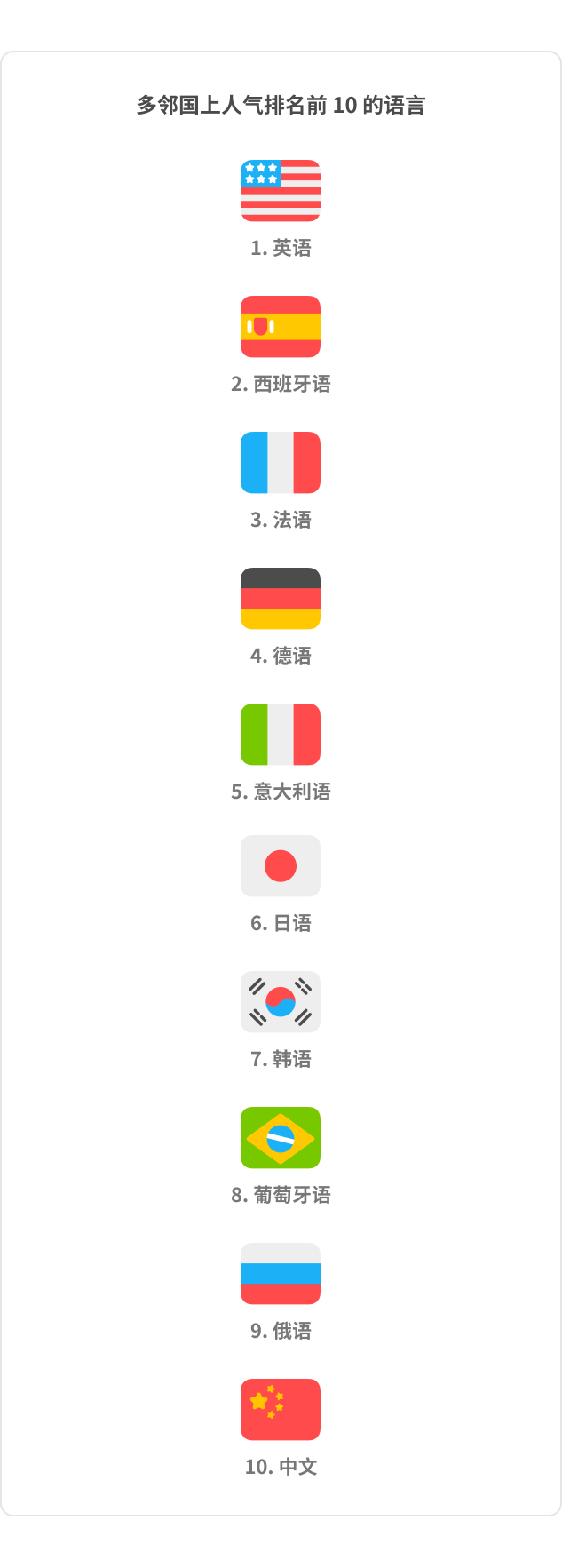
疫情开始后的几周内新增了 3000 万语言学习者
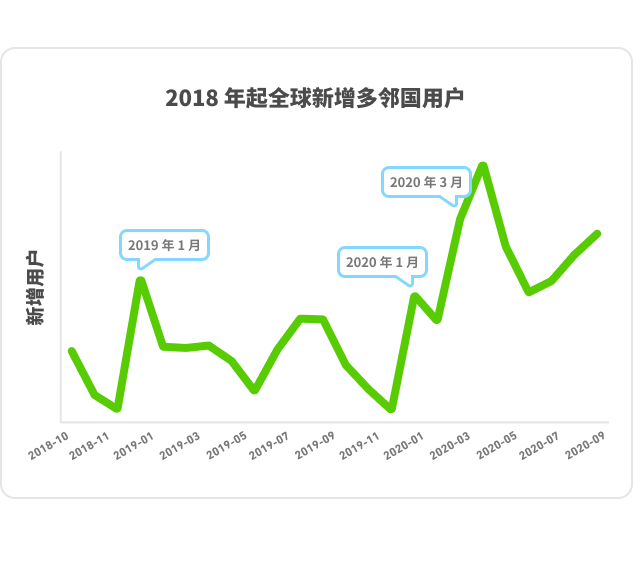
2020 年 3 月,由于受到疫情的影响,有的人突然不再需要通勤、上学,没有了社交活动。世界各地的人们不得不在一夜之间改变自己的日常习惯和作息。在世界卫生组织宣布新型冠状病毒成为全球流行病之后的短短几周内(3 月 11 日至 4 月 30 日),多邻国新增了 3000 万语言学习者,比 2019 年同期多出 67%。这惊人的增长远远超过了典型的新年高峰(许多学习者都会在新年期间制定学习新语言的计划,加入多邻国,造成新年高峰)。全球新冠肺炎期间,新增用户量所达峰值是 2019 新年峰值的 1.5 倍以上,更超出 2020 新年峰值两倍有余。
全球语言学习的趋向变化与政府政策相关,尤其是与政府沟通的清晰度和果断度密切相关。这一点在疫情后尤为明显:在一个国家宣布封城后,那里新增学习者的数量就会显著增加。2 月 20 日中国封城时,出现了第一波新增学习者,而后随着一个个国家实施封城令,每周都会出现新的增长。在延迟封城或对封城决定摇摆不定的国家,学习者的反应也不太统一:像在巴西,直到封城决定落实后,才有多次小规模的增长。增长幅度也因国家和地区而异,学习者增长量高居榜首的是伊拉克。与 2019 年同期相比,伊拉克在 2020 年 3 到 4 月期间足足增长了 640%。中国的大幅持续增长也很值得关注,在2020 年 2 月 20 日封城开始后的很长一段时间,甚至到了 3、4 月份,中国新增用户的涨幅仍在 300% 以上。
在封城的初始阶段,有 27.9% 的人加入多邻国是为了辅助在校学习,提高成绩,但到了 2019 年 3 至4 月就只有 22.6% 。在封城期间,增强脑力训练是学习者的第二大的动力,占了 15.9%。另外,数据还显示疫情期间旅行已不再是学习语言的主要动力。在 2019 年 3、4月间,曾有 19.9% 的学习者为出国旅行而学习语言,但 2020 年开始封城后的几周内,只有 12.7% 的新增用户以旅行为目的学习。
英语仍然是最受欢迎的学习语言; 西班牙语赶超法语荣居第二

长期以来,英语一直是全球通用语言,也是多语环境中旅游、政府和科学教育领域的共同语言标准。因此,英语仍然是全世界最受欢迎的学习语言,在 121 个国家(占所有国家的 62%)人气排行第 1 ,同时还在另外 8 个国家排行第 2。英语水平往往关系到经济和教育机会,因此许多国家的学习者都热衷于学习英语,例如也门、越南、多米尼加共和国、布基纳法索、沙特阿拉伯和危地马拉的学习者中,有 70% 至 80% 都在学习英语,这比例名列英语学习国家之首。英语学习者占比最小的国家,如尼日利亚、津巴布韦、牙买加、菲律宾和博茨瓦纳(有不到 4% 的学习者学习英语),往往都是以英语为官方语言或共同官方语言的。
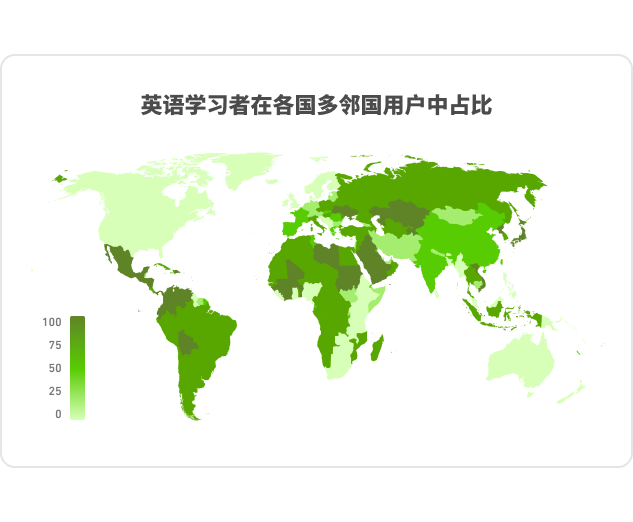
西班牙语和法语是第 2 最受欢迎的学习语言,可是随着时间的推移,学习者与这两种语言之间的关系也在发生变化。法语曾是世界通用语言,我们的2016年分析语言学习趋势报告中显示,法语曾是 35 个国家和地区的最受欢迎的语言,西班牙语紧随其后,受到 32 个国家和地区欢迎。但到了 2020 年,西班牙语已赶超法语。如今,西班牙语在 34 个国家和地区位列人气第 1,而法语霸榜的国家和地区已减少至 23 个。在一些把西班牙语和法语排在第 2 位的国家中,我们同样可以看到这个趋势:法语(71 个国家和地区)和西班牙语(70 个国家和地区)当前是并驾齐驱,但在接下来的一年里,西班牙语也许会超过法国。
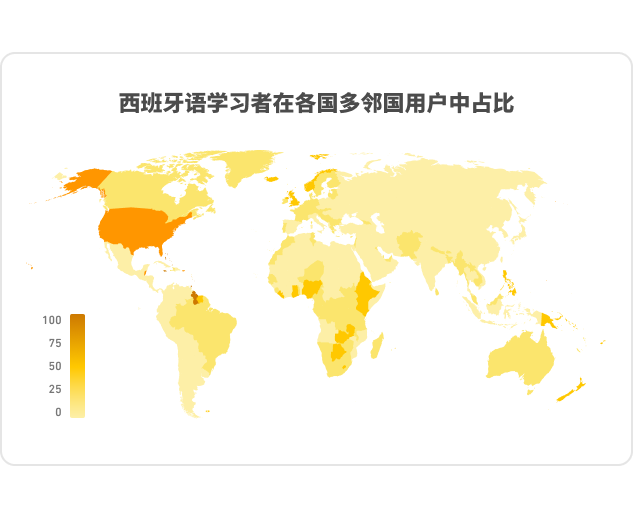
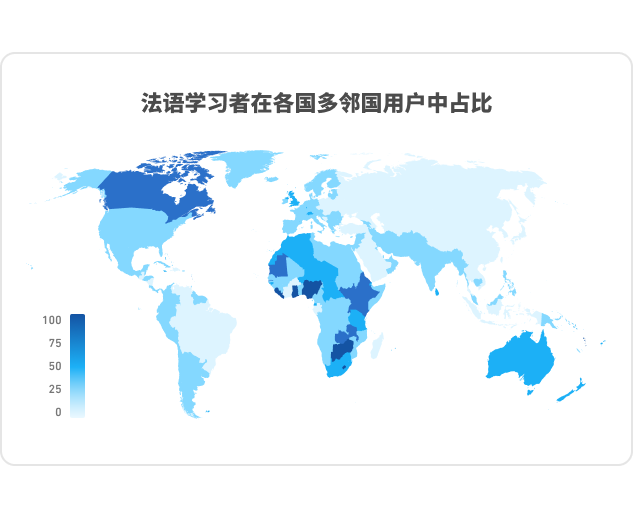
西班牙语的兴起很有可能与拉丁美洲和世界上其他地方之间因旅游、移民和教育而引起的人口流动有关。在世界上越来越多的地区,跟西班牙语社区建立联系和学习西班牙语都变得日趋重要。
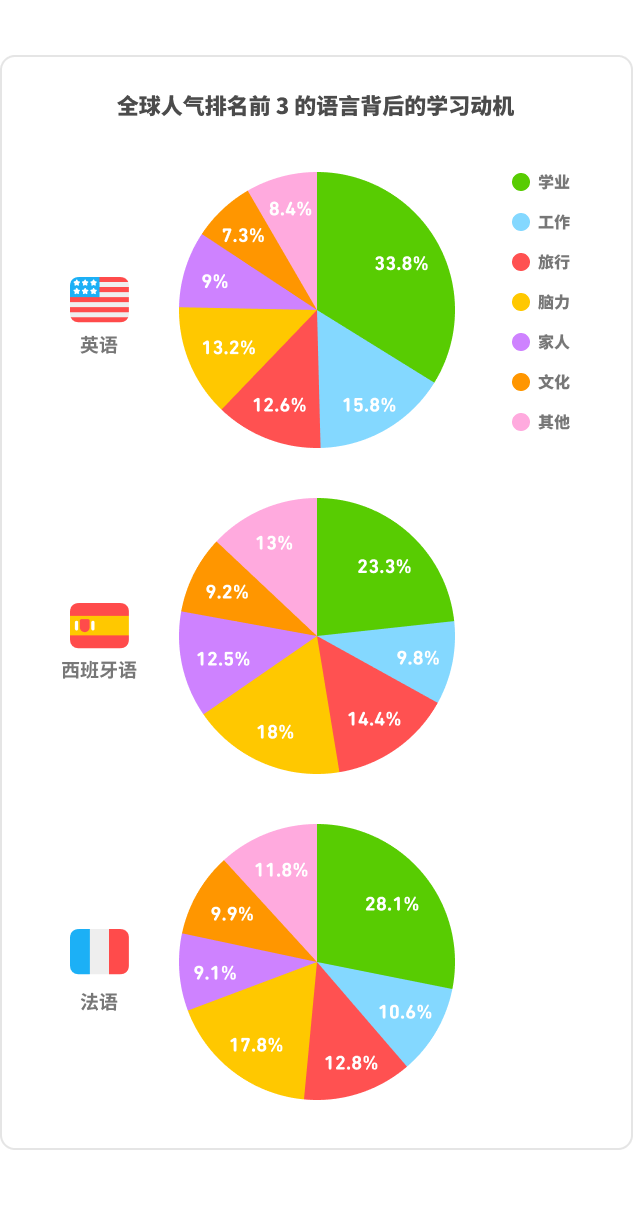
从这里还可以看到,这三大语言背后的学习动机有所不同。提高学习成绩虽然是一个共同的动机,但比起西班牙语和法语,它在英语学习者中更为突出,占了三分之一。学习英语的另一个普遍原因是提升职场竞争力,而学习西班牙语和法语的则更有可能是为了增强脑力锻炼。
各国的语言学习选择
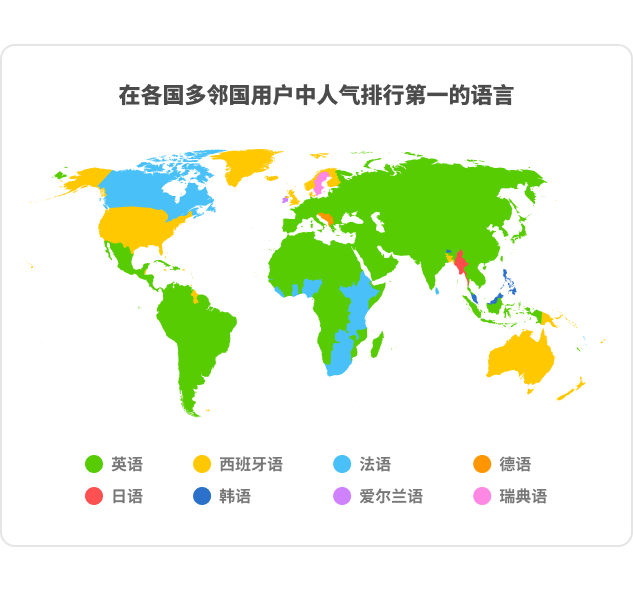
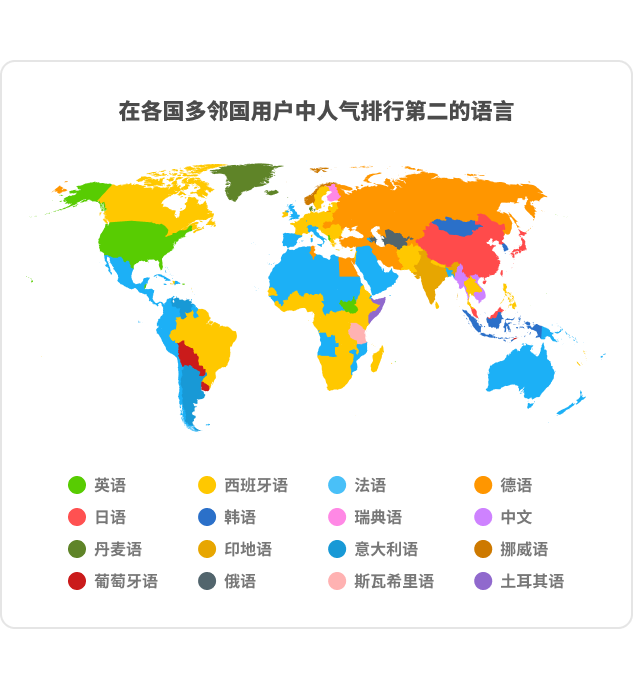
近几十年来,全球人气最高的三大语言一直占有其一席之地,但在世界各地,学习其他语言的趋势也在日益增长。与 2016 年相比,在各个国家和地区人气排名第 1 的语言榜单中,已有更多的亚洲语言,还有一门濒危语言,而意大利语已经不在榜单之内。在各地人气排名第 2 的榜单中,语言种类也有明显增加:从 2016 年的 9 种语言增加到现在的 16 种!2020 年榜单除了包括多种欧洲语言,还增加了 5 种亚洲语言(日语、中文、韩语、印地语和土耳其语)[1] 和一种非洲语言(斯瓦希里语)。
不同国家和地区的语言学习趋势反映了殖民、移民、经济机会、旅游兴趣和历史渊源。语言与人之间的这些复杂联系,解释了为什么法语在非洲部分地区特别受欢迎、为什么瑞典语是瑞典最受欢迎的语言、丹麦语是丹麦第二受欢迎的语言,而整个巴尔干地区都在学习德语。
语言的学习模式还受到流行文化、全球事件和文化趋势的影响,因此我们可以看到时事是如何改变语言学习的。例如,在我们的 2016 年分析中,南美的西班牙语国家特别热衷于学习葡萄牙语,这大概是因为他们紧邻说葡萄牙语的巴西。到了 2019、2020 年,曾在 2016 年风光无限的葡萄牙语在南美已渐渐退出舞台,华年不再。究其原因,先前的热度应该主要是由两项重要的全球事件所推动的,即 2014 年巴西主办的世界杯,和 2016 年里约热内卢的夏季奥运会。时过境迁,随着奖牌颁发时的热情慢慢降温,南美国家对语言的学习热忱也渐渐回归到了英语和法语。如此说来,在 2021 年夏季奥运会之前,全球都会掀起日语学习热潮啦?还是说,奥运所带来的语言繁荣只会影响“近水楼台”的寥寥几个邻国?
放眼世界,有些语言学习趋势还是很博眼球的:
- 日语已经成了人气排行第 6 的语言,学日语的人数已跟学意大利语的不相上下
- 在爱尔兰,爱尔兰语的人气已经超过西班牙语,位居榜首
- 多年来,瑞典语在瑞典人气一直居高。其实,热衷学习本地语言的现象在斯堪的纳维亚国家很普遍:丹麦语在丹麦排第 2,挪威语在挪威也排第 2。就动机而言,过半都是为了扩展职业前景,或是提高学习成绩。在移民当中,对本地语言的学习热情更是高涨!
- 在日本和韩国,本地语言也都排名第 2,但跟斯堪的纳维亚地区不同,这里的主要学习动机是出国旅游
- 2020 年,英语、西语和法语这三大主流都与人气前两名无缘的国家只有文莱、不丹、马来西亚和缅甸。从 2016 年起,这几个东南亚国家就移情于学习韩语、日语和中文了
- 还有一些语言在本国的受欢迎度比在其他任何地方都高:
- 阿根廷的瓜拉尼语(学习动机:20% 提高学习成绩,19% 脑力训练)
- 芬兰的芬兰语(学习动机:20% 家人朋友,20% 职业前景)
- 印度尼西亚的印尼语(学习动机:32% 提高学习成绩,22% 脑力训练)
- 西班牙的加泰罗尼亚语(学习动机:31% 提高学习成绩)
- 美国的夏威夷语(学习动机:21% 脑力训练,18% 文化研究)
- 美国的纳瓦霍语 (学习动机:22% 文化研究,21% 脑力训练)
亚洲语言的人气正在全世界高涨
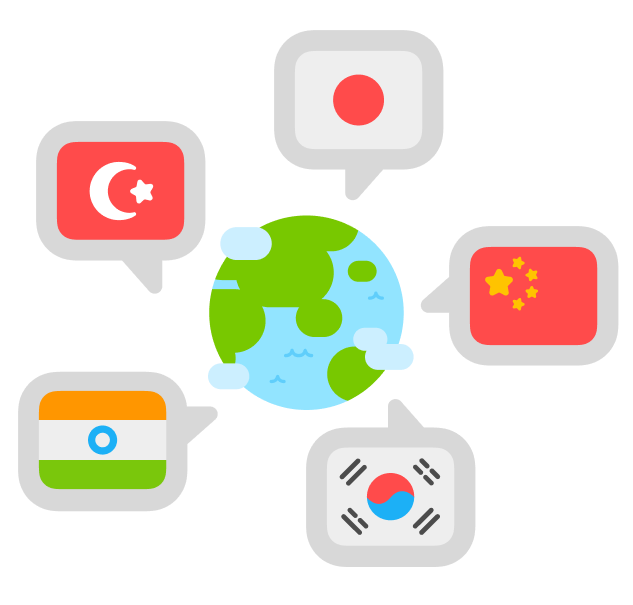
全球发展最快的 5 种语言都是亚洲语言!尽管从语言学角度出发,它们差异颇大,且隶属于完全不同的语言“家族”,但共同之处是,在世界各地的媒体和流行文化中,使用这些语言的群体都在不断壮大。
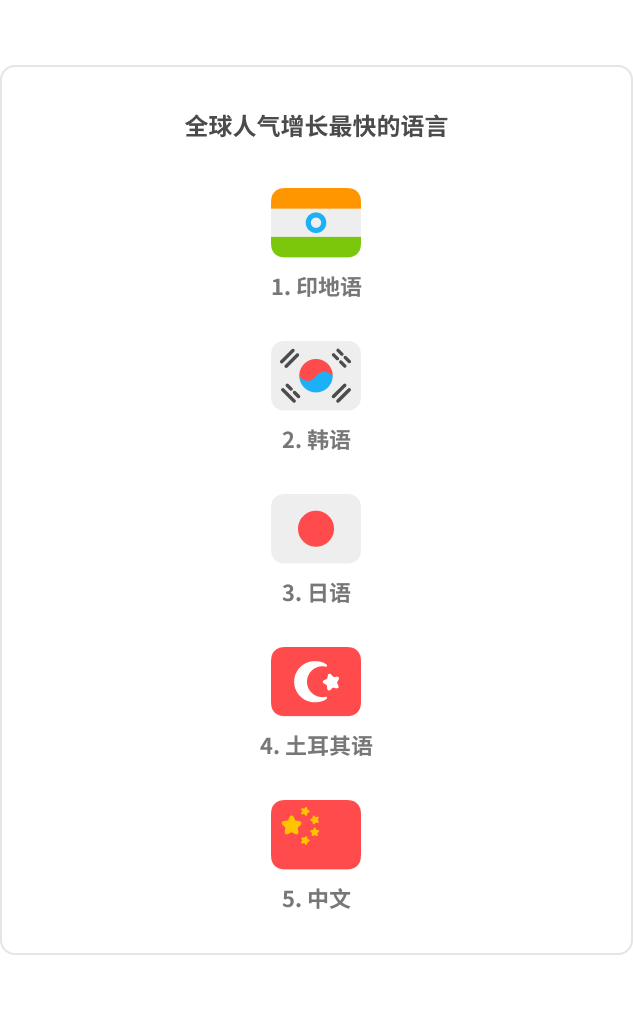
印地语是多邻国课程榜单上最新的一个。要判断它能否保住榜首之位,或确定它受新学习者欢迎的原因,[2] 尚且为时过早。要知道从 2017 年在多邻国推出以来,日语和韩语都已成功撼动了全球语言学习的排行榜。
韩语的发展速度居世界第 2,人气排名全球第 7。 2019 年,韩语已经成了在文莱最受欢迎的语言。今年,在不丹、马来西亚、菲律宾和文莱,韩语都已飙升至人气榜首,而学习韩语人数最多的国家分别是美国、中国、印度、菲律宾和印度尼西亚。不难看出,韩国影响力所及之处,不论亚非,从中国、塞拉利昂、埃塞俄比亚,到不丹和印度,韩语都颇具吸引力。全球韩语学习者的大幅增长,大可归功于同样风靡全球的韩式文化和媒体渗透,其中包括韩国流行音乐,韩剧,以及电影。
日语的发展速度位居世界第 3,人气排名全球第 6。就在去年,日语进入了人气榜,更在缅甸名列第 1。今年,在新加坡和密克罗尼西亚,日语也在人气榜上高居榜首。学韩语人数最多的国家集中在亚洲(除美国外),但学日语人数最多的却包括了西方英语国家,以美国为首,其次是中国、英国、印度和加拿大。跟韩语一样,日语增长最快的国家也横跨亚非,分别是中国、乍得、不丹、塞舌尔和埃塞俄比亚。正如韩国,日本文化,包括动漫在全球的影响力 同样可能是日语学习者持续显著增长的根源所在。
亚洲语言的迅速崛起表明,全世界人民对亚洲语言和亚洲文化的热情绝非昙花一现。纵使今日英语、西语和法语仍高居榜首,语言学习的趋势却已在迅速改变:韩语今年已上升了两个名次(2019 年曾位列第 9),且中文应该会在明年年底就取代俄语,成为第 9 名。
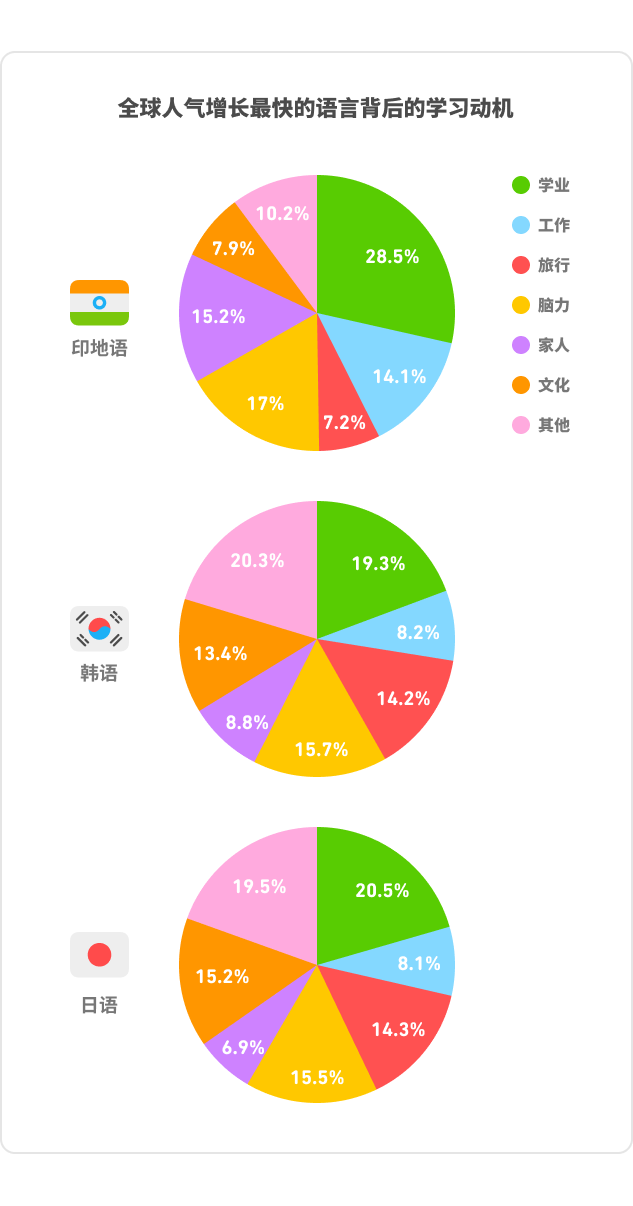
就学习动机而言,学习这些亚洲语言的最重要的原因是提高学习成绩,其次是增强脑力训练。学习日语和韩语的主要目的是出国旅游和了解世界文化,这也进一步证明,韩国流行音乐及娱乐产业对语言学习趋势产生了深远影响;而学习印地语的人,更多是为了能与家人朋友进行沟通。
世界各地的学习习惯有何不同?
无论是学习哪种语言,动机为何,要想学到得心应手,就必须坚持!今年,德国的人均学习量最多,已取代日本,成为全球之最。
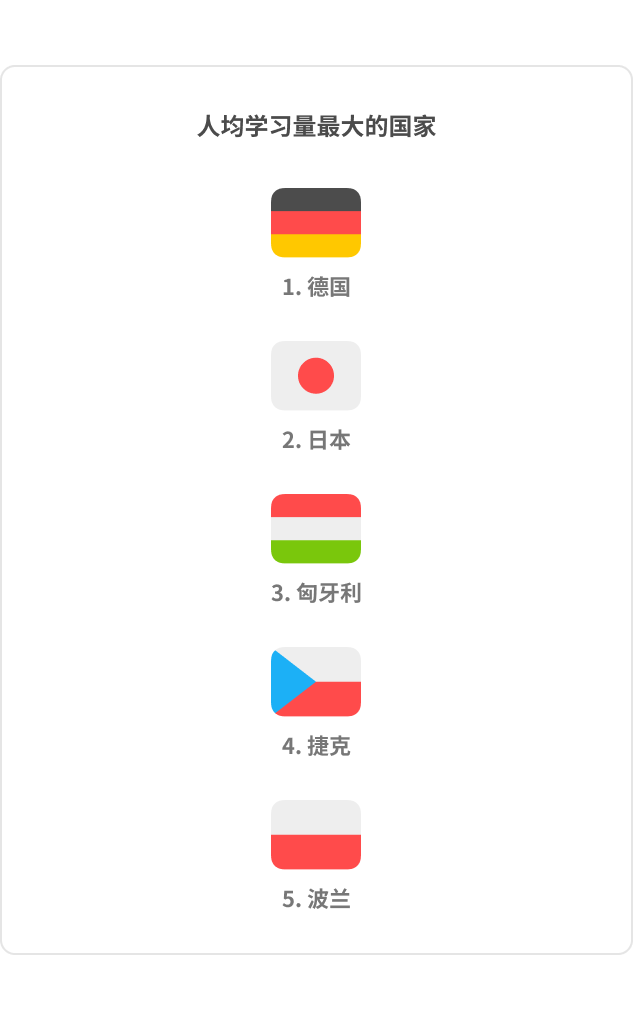
有趣的是,人均学习量较多的国家,往往也是在多邻国坚持学习最久的国家。这些国家的学习者在很长一段时间内,会毫无间断地坚持每天学习。匈牙利学习者坚持学习的时间最久,其次是日本和德国。
很显然,日本、德国和匈牙利的学习者成绩斐然,他们既肯下功夫,又很有恒心。但并非所有的学习者都能在这两方面同时出彩。看看我们的分析报告,就能了解哪些国家是“细水长流型”(恒心是有的,但每次只学一点点),哪些是“狂暴学习型”(一股脑完成很多单元,但难以持之以恒)。
在学习时间的安排上,各方的一致性倒是很强:迄今为止,最普遍的仍是安排在晚上学习,有一半的国家在晚上 10-11 点最活跃,另外 41.6% 的国家时间略早,在晚上 9-10 点。当然也有例外,比如有五个国家的学习时间安排有点与众不同:摩纳哥在下午 5-6 点学习的人最多;法国是在傍晚 6-7 点;巴巴多斯、多米尼加和西班牙则是在晚上 7-8 点更爱学习。这些更多可能是体现了日常生活习惯上的差异,比如午餐和晚餐的时间较晚的话,会用晚饭前的时间来学习语言,所以会早一点吧。
如果你想了解更多,可以参考我们向公众开放的 2020 年数据子集。点这里前往查看。
所用数据说明
《2020 年语言学习趋势报告》收集了 2019 年 10 月 1 日至 2020 年 9 月 30 日期间在多邻国上学习语言的学习者信息。数据均已按国家或语言进行分类汇总,以确保学习者的隐私。为保护学习者隐私,凡多邻国学习者少于 5000 名的国家均不参加排名。
[1] 尽管土耳其本身与欧洲和亚洲都有紧密的联系,将土耳其语归为亚洲语言的原因是土耳其语和其他突厥语系跟整个亚洲,尤其是中亚都有其渊源。
[2] 我们将密切关注印地语明年的发展。印地语最近人气骤增可能与 2020 年多邻国在印度的大幅增长有关,今年印度的印地语学习者比其他任何国家都多。用户研究表明,数据增幅的起因可能更多的是与印度用户参加体验有关,而不是印地语(印度的官方语言之一)的学习。
日本語: 2020年版Duolingo言語レポート
他では見られない今年の言語学習の傾向をお届け
序文 ルイス・フォン・アン
私たちは「誰もが利用できる、世界最高の教育を開発すること」を使命として、2011年にDuolingoを設立しました。経済的不平等は、人類が直面している最大の問題の一つであり、教育が世界中の人々の生活を向上させるための一番の方法だと、私は常々思っていました。私たちは、経済力に左右されずに、より良い教育機会を得ることができる世界の構築を目指しています。
過去9年間で、Duolingoは世界で最も人気のある言語学習方法となり、世界で最もダウンロードされている教育アプリとなりました。私たちのアプローチにより、世界中で総ユーザー数5億人以上、月間アクティブユーザー数約4,000万人という巨大な規模を達成することができました。私たちはデータを非常に重視している会社です。ユーザーに直結するすべての側面をテストして測定し、そのデータを基に教え方などを常に改善しています。その結果、世界の言語学習の傾向に関して、史上最多とも言える知見を得ました。
なぜ私たちは世界の言語学習の傾向に関心を持つ必要があるのでしょうか?そして、そこから何を学ぶことができるのでしょうか?世界中の国や地域が学習している言語は、私たちの過去の歴史と現在の文化を反映しており、国際社会がどのような方向に向かっているのかを知る手がかりを与えてくれるかもしれません。私たちのデータの傾向は、植民地化、移民、経済、文化の影響を映し出しています。これらの要因は、2020年の最も重要な傾向として顕著に現れています。
世界中で学習されている言語は常に英語がトップですが、2番目に人気のある言語はその年の傾向を示す鍵となります。今年はこれまで以上に多くの国で、2番目に人気の言語として、スペイン語がフランス語を追い抜いたことがわかりました。また、韓国映画がアカデミー賞で作品賞を受賞し、日本でオリンピックが開催されることになった今年は、アジア言語の学習が増加しました。ラテンアメリカやアジアの文化的影響力は、引き続き拡大する傾向にあるでしょう。
しかし、今年は新型コロナウイルスほど大きな影響を及ぼしたものはありません。私たちの日常生活のほぼすべての面に影響を与えた、新型コロナウイルス感染症の世界的大流行は、言語学習にも大きく影響しました。都市封鎖措置が発動され始めると、世界中で言語学習をする人々が急増しました。この増加は、必ずと言ってよいほど政府の対策開始のタイミングと一致していました。世界的大流行発生後の数週間で、3000万人以上の人々がDuolingoで言語学習を始めましたが、学習の動機や学習する言語は変化しています。この後ご紹介する「Duolingo言語レポート」は、Duolingo独自の視点を世界中の国々へ向けて発信するために作成されました。
目次
- 都市封鎖後の数週間で3,000万人が新たに言語学習を開始
- 英語は依然として最も人気のある学習言語 スペイン語がフランス語を抜き第2位に
- どの国がどの言語を勉強しているのか?
- 世界中でさらに多くのアジア言語が学ばれるように
- 勉強の習慣は世界でどのように違うのか?
- 世界の言語動向を徹底分析
この2020年版のDuolingo言語レポートには、世界中の言語学習の傾向、パターン、分析が含まれています。私たちのデータは、これまでに収集された最も包括的なサンプルの言語学習状況を反映しています。私たちは5億人以上の学習者を抱えており、世界のすべての国、194か国に学習者がいます。Duolingoは無料で利用でき、モバイルアプリとウェブサイトで利用できるため、あらゆる生い立ちや経歴を持つ学習者が私たちのプラットフォームを利用しています。Duolingoの言語コースには、全大陸の言語、存続の危機に瀕している言語、先住民族の言語、2つの架空の言語、1つの古典言語、そして、それぞれ異なる言語を話す人を対象とする22の英語コースがあります。このレポートでは、どの国がどの言語を学習しているのか、異なる言語を学ぶことへの関心が時間の経過とともにどのように変化してきたのか(特に私たちの 「2016年の分析」 以降と今年の新型コロナウイルスの世界的流行にかけて)、学習者の行動が世界でどのように変化しているのかを調査したものです。
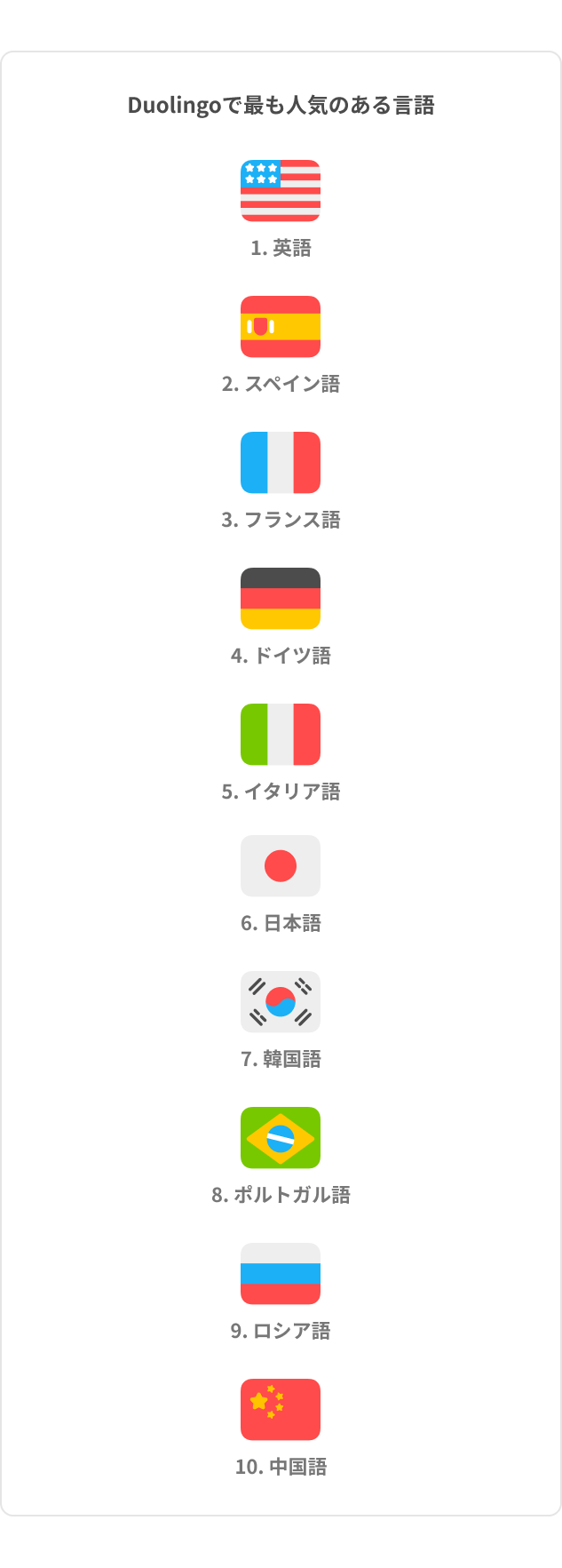
都市封鎖後の数週間で3,000万人が新たに言語学習を開始
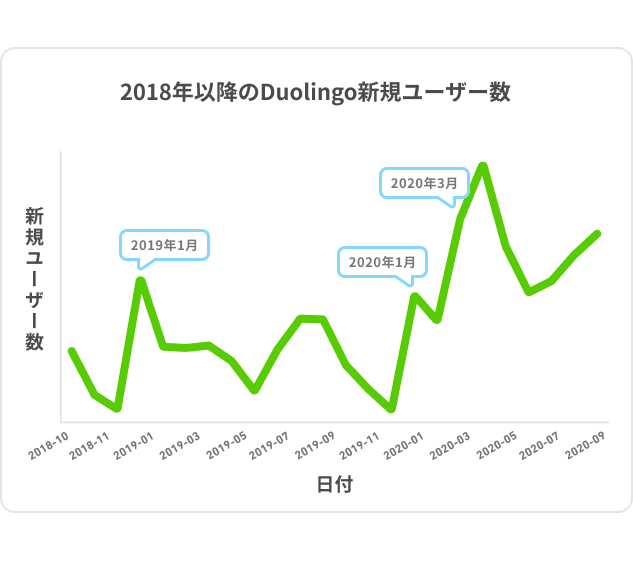
2020年3月に突然、通勤、通学、社会活動ができなくなったことに気がついたとき、世界中の人々は一夜にして習慣や日常生活を変えなければなりませんでした。WHO(世界保健機構)が新型コロナウイルス感染症の世界的大流行を発表した直後の数週間(3月11日~4月30日)に、3,000万人の新規学習者がDuolingoで言語学習を開始しましたが、これは2019年の同時期と比較して67%増加しています。言語学習におけるこの信じられないほどの成長は、多くの学習者が新年の抱負として参加する典型的な新年の学習者急増よりも、はるかに大きいものでした。この世界規模での新型コロナウイルスによる急増は、私たちの2020年1月の急増の2倍以上、2019年1月の急増の1.5倍以上の規模でした。
世界中の言語学習の変化は、政府の政策と密接に関連しており、特に政府がどれだけ明確かつ断固とした方法でそれを伝えたかということに関係していました。これは 「都市封鎖」の直後にすでに明らかになっていました。各国が都市封鎖を発表した途端に、新規学習者が大幅に増加したのです。中国では、2月20日に都市封鎖が行われた際、新規学習者の最初の急増の波を経験しました。そしてその他の国においても同様、都市封鎖を実施するとすぐに毎週のように多くの新規学習者がDuolingoに参加しました。都市封鎖の決定が遅れたり揺らいだりした国では、学習者の反応も一様ではありませんでした。ブラジルのように、都市封鎖の手順が明確になり、広く受け入れられるようになるまで、何度も小刻みな増加を経験した国もあります。言語学習の成長の大きさは国によって異なりますが、イラクは2019年の同時期と比較して、2020年の3月から4月の間に新規学習者が640%増加しトップとなっています。また、中国の莫大な成長も注目に値します。特に2月20日の都市封鎖後も、学習者が長い間一貫して言語学習を継続していたことから、中国の新規学習者は数週間後の2020年3月と4月にも300%以上の伸びを示しました。
当初、新規学習者は学校の授業を補うためにDuolingoへ参加しており、言語学習の主な動機として学校が挙げられたのは27.9%であったのに対し、2019年3月~4月に学校のために参加していた学習者は22.6%でした。脳トレ(15.9%)は、都市封鎖中に言語学習を始めた理由の中では1位と大きく差のある第2位でした。当然のことながら、海外旅行は学習者の動機にはなりませんでした。2019年3月〜4月に旅行を理由に言語学習を始めた学習者は19.9%でしたが、2020年の都市封鎖の最初の数週間に、新しい言語を海外で使うことを夢見ていたのは、新規学習者の12.7%に過ぎませんでした。
英語は依然として最も人気のある学習言語 スペイン語がフランス語を抜き第2位に

英語は長い間、世界中で事実上の共通語となっており、観光、政府、科学、教育など、多言語環境やコミュニティでの言語的共通項としてよく使用されてきました。その結果、英語は世界中で最も人気のある学習言語となっています。121か国(すべての国の62%)で英語は学習する言語のトップであり、さらに8か国では2番目に人気のある言語となっています。英語の習熟度は経済的及び教育的な機会にも関係しており、多くの国では学習者が一様に英語の学習に力を入れていることがわかります。例えば、イエメン、ベトナム、ドミニカ共和国、ブルキナファソ、サウジアラビア、グアテマラは、学習者の70%から80%が英語を学習しており、英語を学習している国々の最上位に位置しています。一方、英語学習者の割合が最も低い国では、すべて英語を公用語(または共同公用語)として使用しています。
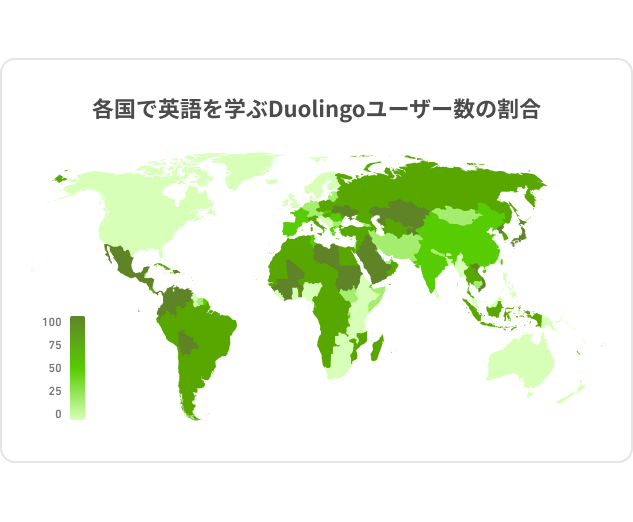
次に学習する言語として人気が高いのはスペイン語とフランス語ですが、学習者のこれらの言語との関係は時間と共に進化しています。かつてはフランス語が世界の共通語として君臨していましたが、言語学習の傾向を分析した「2016年の分析」(ブログ)では、フランス語は35か国で学習される言語のトップであり、スペイン語は32か国で僅差で後れを取っていました。しかし、2020年までには、スペイン語がフランス語を圧倒的に追い抜いています。現在、スペイン語は34か国において最も人気のある学習言語であり、フランス語は23か国にまで落ち込んでいます。このパターンは、それぞれの言語が2番目に人気のある国の数にも同様に見られ、フランス語(71か国)とスペイン語(70か国)が拮抗しており、来年にはここでもスペイン語がフランス語を上回る可能性があります。
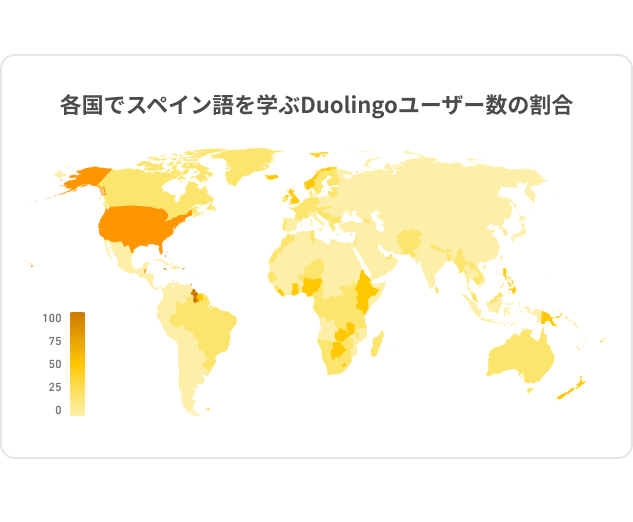
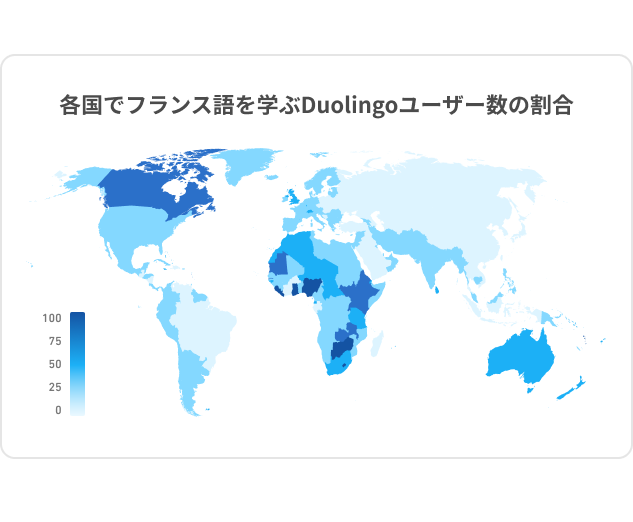
スペイン語の台頭は、観光、移民、教育のためのラテンアメリカと世界の他の地域との間の 「人々の移動」 に関連している可能性が高いです。世界の多くの地域で、スペイン語を学び、スペイン語圏のコミュニティとつながることが、これまで以上に重要になってきています。
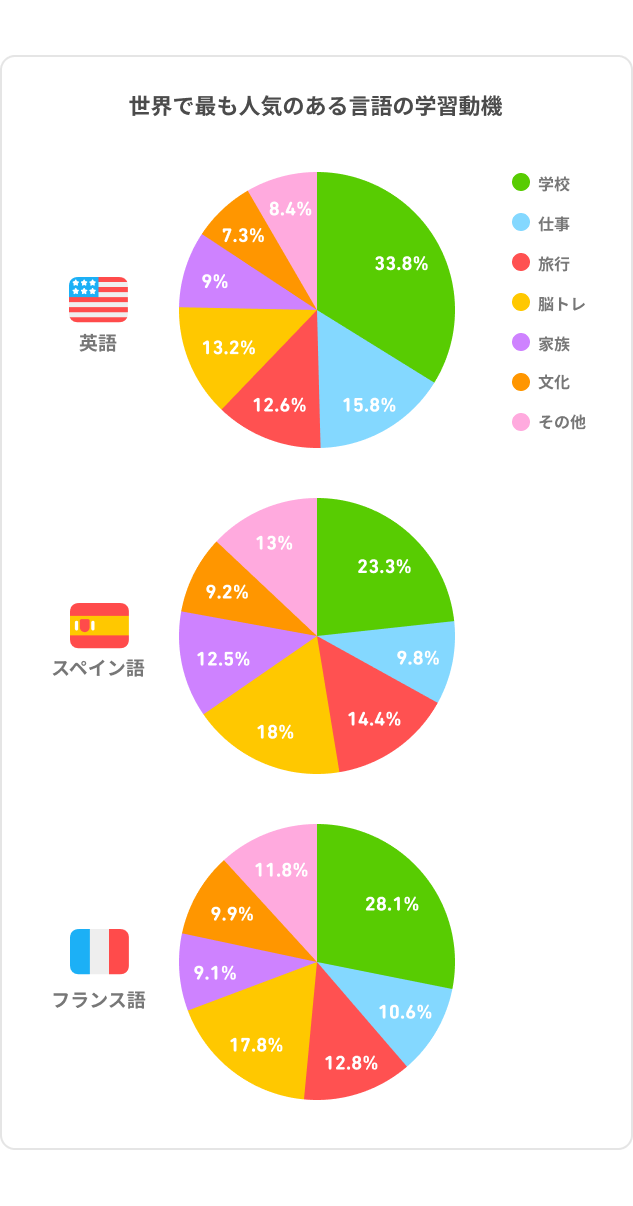
また、上位3言語の間で、学習動機にも違いが見られます。3つの言語とも学校が人気の理由ですが、スペイン語やフランス語よりも英語の方が学校がより強い動機となっており、英語学習者の3分の1は学校のために勉強しています。仕事は英語学習者の次に多い学習動機ですが、スペイン語やフランス語の学習者は脳トレのために勉強している人が多いようです。
どの国がどの言語を勉強しているのか?
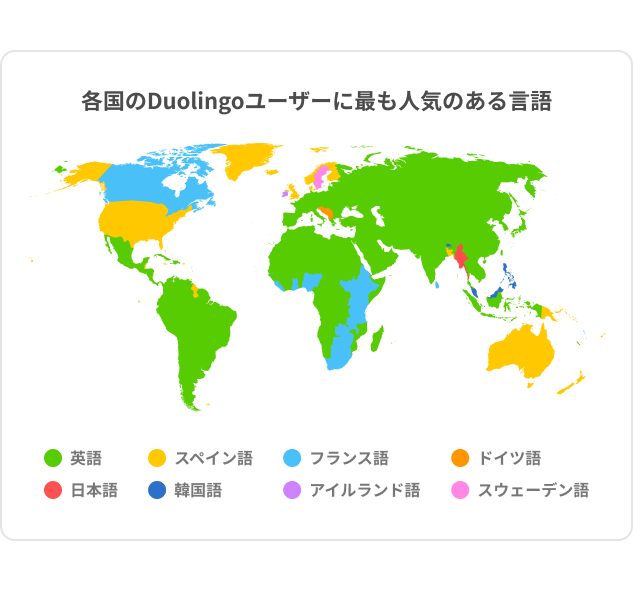
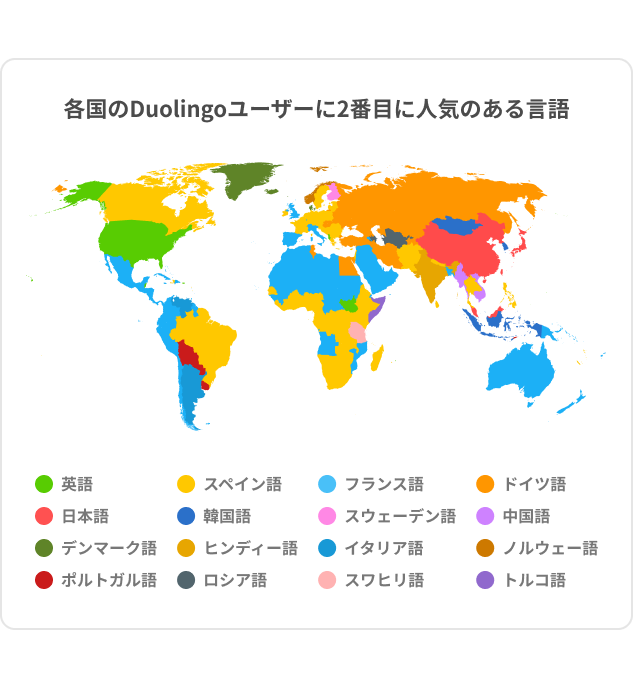
世界で学習されている言語のトップ3はここ数十年で安定していますが、世界的にはより幅広い言語を勉強する方向にシフトしています。2016年と比較すると、各国で学習されている言語のトップ3には、アジアの言語と絶滅危惧種の言語が含まれており、リストから除外された言語のひとつはイタリア語です。2番目に人気のある言語は数が増加しており、2016年には9言語が含まれていましたが、現在では16言語となっています。2020年の該当言語には、予想通りヨーロッパの言語が多く含まれていますが、アジアの5言語(日本語、中国語、韓国語、ヒンディー語、トルコ語)[1] とアフリカの1言語(スワヒリ語)も含まれています。
世界中の国や地域が学ぶ言語は、植民地化、移民や経済機会、旅行への関心、歴史的なつながりを反映しています。このような人々と言語の複雑なつながりがあるからこそ、アフリカの一部ではフランス語が特に人気があり、スウェーデンではスウェーデン語が最も人気があり、デンマークではデンマーク語が2番目に人気があり、バルカン半島の至る所でドイツ語が学習されているのです。
言語学習のパターンは、ポップカルチャーや世界的な出来事、文化的なトレンドにも影響されるため、現在の出来事が言語学習をどのように変化させているかを見ることもできます。例えば、2016年の分析では、南米のスペイン語圏の国々は特にポルトガル語に熱心であるように見えましたが、これはおそらくポルトガル語圏の隣国であるブラジルの影響でしょう。しかし、2019年と2020年には、南米におけるポルトガル語人気は下火になりました。何が起こったのでしょうか?私たちは、ブラジルの言語に対する2016年の関心が、2014年のワールドカップ(ブラジル主催)と2016年のリオデジャネイロでの夏季オリンピックという2つの重要な世界的イベントによって後押しされたのではないかと推測しています。メダル獲得から何年も経った今、南米の国々が英語やフランス語の学習を再開しています。果たして、2021年の夏季オリンピックを前に、世界的に日本語学習者が急増するのでしょうか?それとも、オリンピックの盛り上がりは周辺国だけのものになるのでしょうか?
他にも世界中の注目すべき言語学習の傾向をご紹介します。
- 日本語は今では人気の言語第6位となり、イタリア語の学習者数とほぼ同じくらい多くの人が日本語を学習しています。
- アイルランドでは、アイルランド語がスペイン語を抜いて学習言語のトップに躍り出ました。
- スウェーデンではスウェーデン語が最も学習されている言語であることは何年も前から知られていますが、他の北欧の国でも、自国語の学習者が特に多いことがわかっています。デンマークではデンマーク語が第2位、ノルウェーではノルウェー語が第2位となっています。北欧の移民コミュニティは、特に自国の言語を学ぶことに力を入れています。
- 日本と韓国では、北欧と似ているようですが状況が違います。これらの国では、それぞれの国の言語が2番目に人気の学習言語となっているものの、北欧の学習者の学習動機と異なり、旅行が大きなモチベーションになっています。
- 2020年に、学習言語のトップ2に英語、スペイン語、フランス語が入っていない国は、ブルネイ、ブータン、マレーシア、ミャンマーのみとなりました。2016年以降、これらの東南アジア諸国は、従来のトップ3よりも韓国語、日本語、中国語を勉強する方向に進んでいます。
- いくつかの言語は、地球上のどこよりも自国で人気があります。ここでは、自国内で最も多くの学習者がいる国をご紹介します。
- アルゼンチンにおけるグアラニー語(動機:学校20%、脳トレ19%)
- フィンランドにおけるフィンランド語(動機:家族20%、仕事20%)
- インドネシアにおけるインドネシア語(動機:学校32%、脳トレ22%)
- スペインのカタルーニャ語(動機:学校31%)
- アメリカにおけるハワイ語(動機:脳トレ21%、文化18%)
- アメリカにおけるナバホ語(動機:文化22%、脳トレ21%)
世界中でさらに多くのアジア言語が学ばれるように
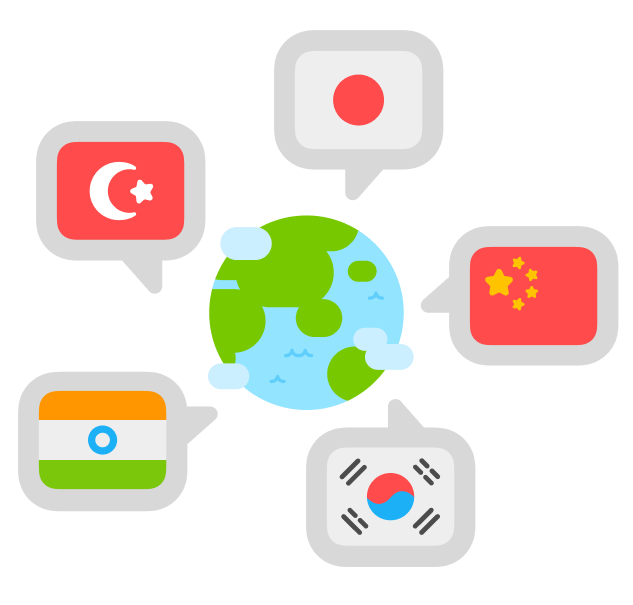
世界で最も急速に成長している5つの言語はすべてアジアの言語です。言語自体は言語学的に非常に多様ですが(5つの言語はすべて全く異なる言語の「語族」から派生しています)、共通しているのは、それらの言語が世界中のメディアやポップカルチャーの中で存在感を増しているコミュニティで話されているということです。
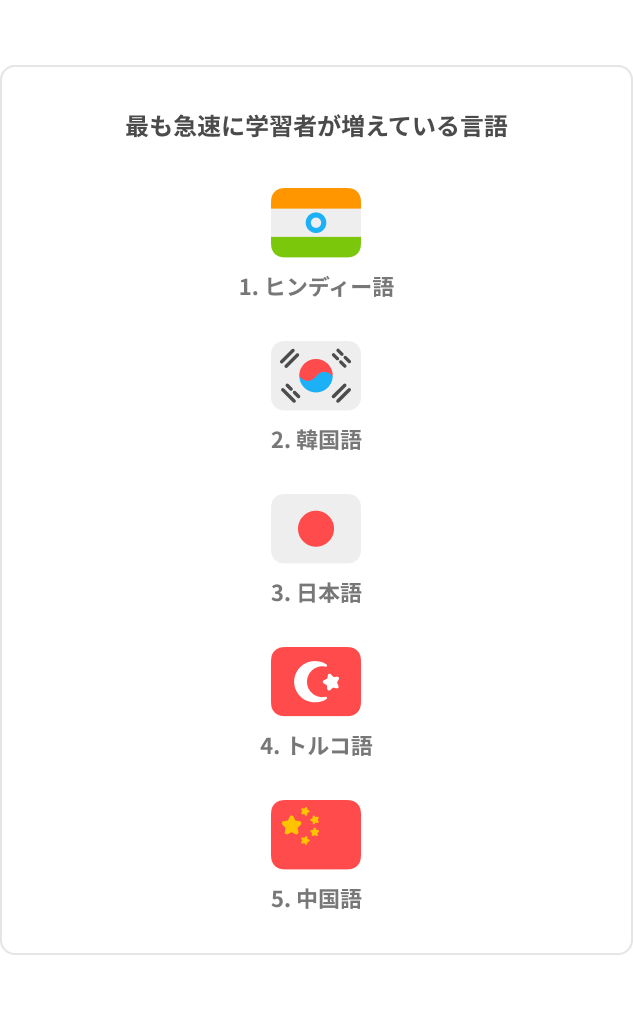
ヒンディー語はこの中で最も新しいDuolingoコースですが、このままトップの座をキープできるのか、新しい学習者たちをヒンディー語学習に駆り立てるものが何であるのかは、まだわかりません。[2] 2017年にDuolingoで導入されて以来、世界中の言語学習チャートを揺るがしてきた2つのアジア言語の日本語と韓国語は、トップ5リストのスーパースターであり、この2言語に対抗してどのような成績を残すのか、来年のヒンディー語の成長を注視していきたいと思います。
世界で2番目に急速に成長している言語である韓国語は、世界で最も人気のある学習言語の第7位になっています。2019年にはすでに1か国(ブルネイ)で韓国語が最も人気のある言語となっており、今年はブルネイに加えてブータン、マレーシア、フィリピンでも韓国語の人気により1位に浮上しています。韓国語学習者数が最も多いのは、アメリカ、中国、インド、フィリピン、インドネシアです。また、韓国語が最も急速に普及している国では、アジアやアフリカの多様な層にも韓国語の魅力が広がっていることがわかります。中国、シエラレオネ、エチオピア、ブータン、インドなどです。世界中の韓国語学習者の目覚ましい成長は、「K-pop」や、「ドラマ」、そして 「映画」 などの韓国文化やメディアへの関心が世界的に急速に高まっていることに起因していると考えられます。
日本語は世界で最も急速に成長している言語のリストで3位を獲得し、世界で最も人気のある学習言語の中では第6位になっています。昨年はミャンマーで日本語が1位となり、今年はシンガポールとミクロネシア連邦が日本語を学習言語のトップとする国のリストに加わりました。韓国語を学ぶ国はアメリカに加えてアジアに集中していますが、日本語学習者数が多いのは西側の英語圏の国で、アメリカがトップで、さらに中国、イギリス、インド、カナダと続いています。しかし、韓国語と同様に、日本語学習者が最も増加している国は、アフリカやアジアの学習者も含まれています。日本語が最も伸びている国は、中国、チャド、ブータン、セイシェル、エチオピアです。また、韓国語と同じように、「マンガ・アニメ」 を含む日本文化への世界的な関心が、世界中の日本語学習者の持続的かつ大きな成長の要因となっていると考えられます。
アジアの言語が急上昇していることは、これらの言語とその文化に対する世界的な関心が単なる流行ではないことを示しています。2020年には英語、スペイン語、フランス語が軽々とリストの上位に立つかもしれませんが、言語学習の傾向は急速に変化しています。今年は韓国語が2つ順位を上げ(2019年は9位)、来年末には中国語がロシア語を抜いて9位になる予定です。
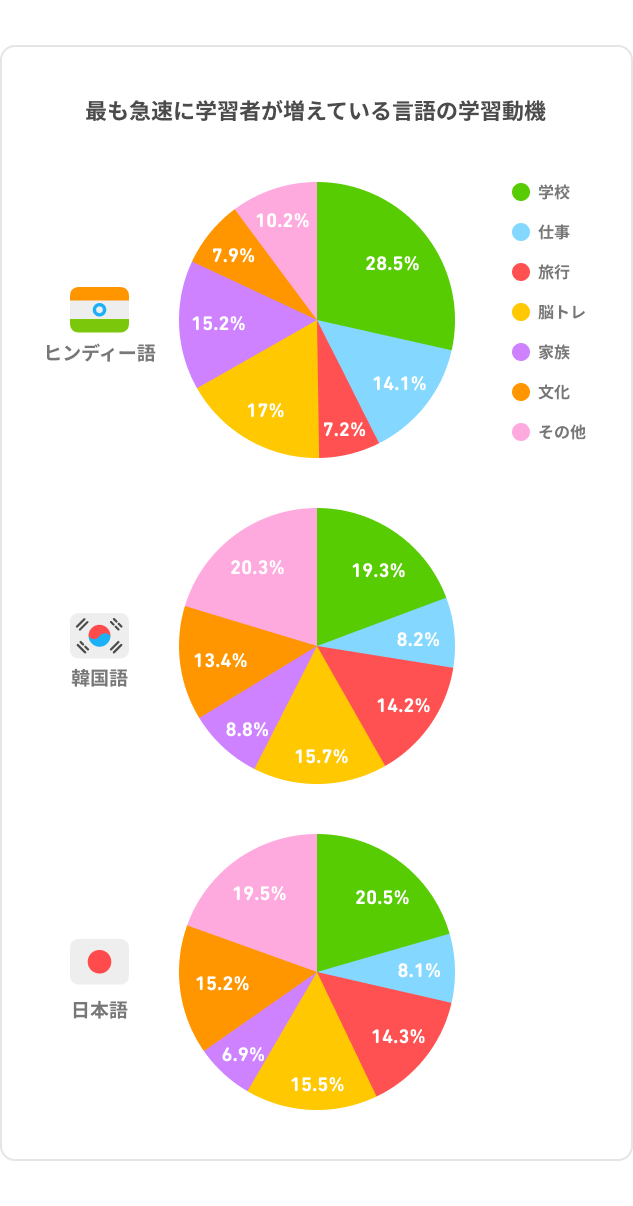
学習者の動機は、アジアの言語を学ぶ上で最も重要な動機は学校のためであり、次いで脳のトレーニングであることを示しています。韓国や日本の学習者にとっては、旅行や文化が重要な学習動機となっており、K-POPやエンターテイメント産業が、言語学習のパターンに影響を与えていることがうかがえます。一方、ヒンディー語の学習者は、家族とのコミュニケーションを動機に言語を学習する傾向が強くなっています。
勉強の習慣は世界でどのように違うのか?
どの言語をどのような理由で勉強しているのかにかかわらず、言語を自信を持って使いこなせるようになるには粘り強さが必要です。世界で最も学習熱心な国は、学習者一人当たりのレッスン数が最も多い国であり、今年はドイツが日本を抜いて、最も学習熱心な学習者を持つ国の栄誉を獲得しました。
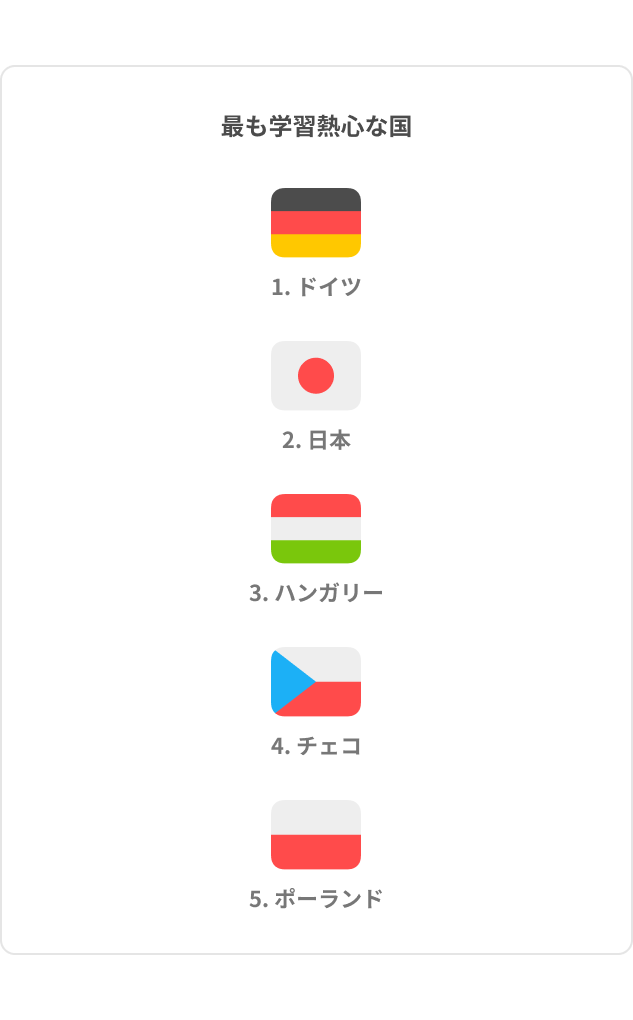
興味深いことに、最も学習熱心な国の多くは、最も「勤勉な」国でもあります。彼らはDuolingoで最も長い連続記録を持っており、レッスンを休むことなく、定期的に戻ってきて、これを長期間続けています。最も勤勉な国のトップはハンガリーで、2位が日本、3位がドイツと続いています。
日本、ドイツ、ハンガリーで、学習熱心で勤勉な学習者が多いのは明らかですが、すべての学習者がこの2つの特徴を兼ね備えているわけではありません。国別レポートでは、どの地域の学習者が「非常に熱心だが一度に少ししかやらない」コツコツタイプか、どの地域の学習者が「たくさんのレッスンをこなしながら短時間で学習する」熱血タイプなのかを紹介しています。
学習者は学習する時間帯に一貫性があり、学習の時間帯は夜が圧倒的に多く、全世界の半数の国で22~23時が最も多く、さらに41.6%の国では21~22時と少し早い時間帯となっています。しかし、非常に異なるスケジュールの国が5か国あります。モナコの学習者は午後5時から6時が最も多く、次いでフランスが午後6時から7時、バルバドス、ドミニカ、スペインが午後7時から8時の間に学習しています。これらの例外は、他の国に比べて昼食や夕食の時間が遅いため、夕方の早い時間に言語学習を行うことができるという、学習者のスケジュールの違いを反映していると考えられます。
なお、一般公開されている2020年のデータの一部は、こちらからご覧いただけます。
データについて
2020年版Duolingo言語レポートには、2019年10月1日から2020年9月30日までの間にDuolingoで言語を学習した学習者の情報が含まれています。このデータは、学習者のプライバシーを確保するため、国別または言語別に集計されています。国別集計は、国際的に認められている独立した自治組織に基づいています。詳細は こちら をご覧ください。また、学習者のプライバシー保護の観点から、Duolingoの学習者数が5000人未満の国はランキングから除外しています。
[1]: トルコ語自体はヨーロッパとアジアの両方と密接な関係を持っていますが、トルコ語をはじめとするツルキ語族はアジア全域、特に中央アジアにルーツを持っていることから、トルコ語をアジア言語として分類しています。
[2] 今後1年間のヒンディー語の成長に注目して、ヒンディー語がどのように推移するかを見ていきたいと思います。この言語の最近の人気の一部は、2020年のDuolingoのインドにおける大幅な成長に関係している可能性があります。そして今年は、他のどの国よりも多くのヒンディー語学習者がインドにいたことも分かっています。ユーザー調査によると、これはヒンディー語(インドの公用語のひとつ)の学習よりも、インドにおけるユーザー体験に関係しているのかもしれません。
